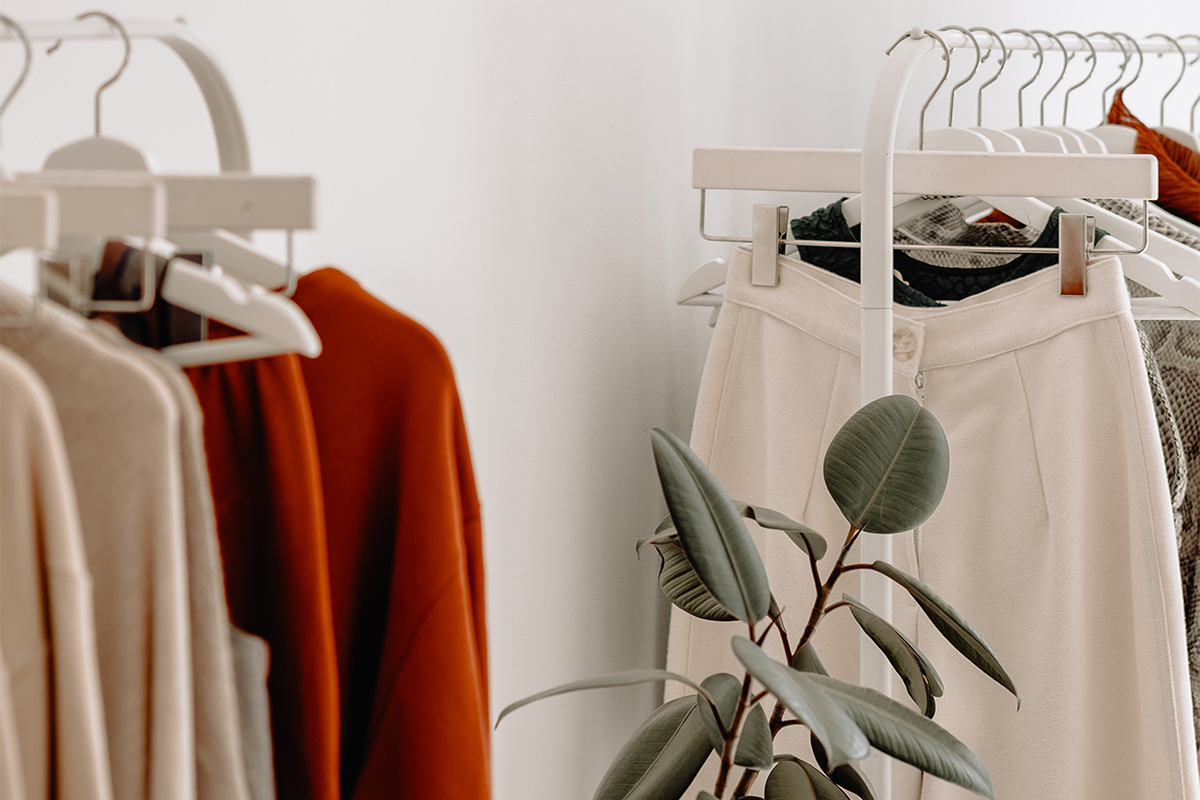
Step into Autumn with an edit from personal shopping service luminaire.com. Compiled by Harriet Quick and Isabel Froemming
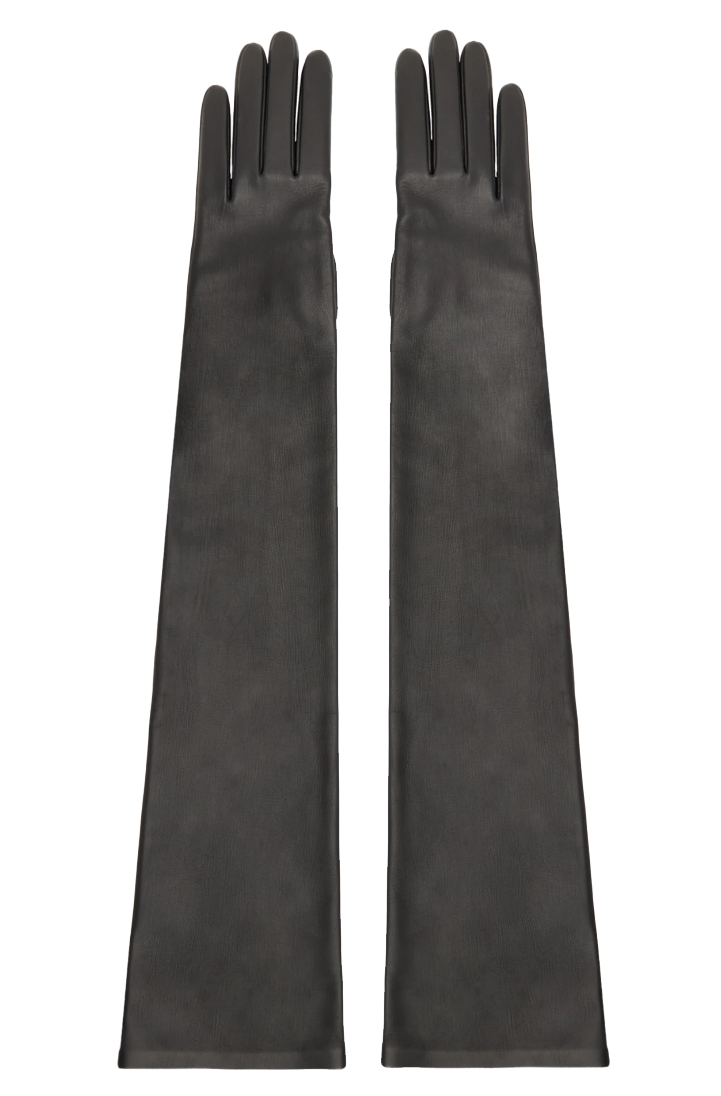
Elbow room
Opera gloves are the accessory for now, perfectly bringing a touch of haute couture elegance to casual looks. This above-the-elbow pair by stealth-luxury brand The Row are cut from the softest lamb leather and lend a soignée touch to the simple slip dress. Think Audrey Hepburn in breakfast at Tiffany’s and add a cocktail ring on top.

Adorn me
Emblematic costume jewellery from Virginie Viard‘s Métiers d’art collection for Chanel creates a strong statement with the Byzantine motifs that Coco Chanel adored. The collection was shown in Dakar, Senegal, celebrating the vibrant culture and craft of the region. Combine and layer chains for a custard décolleté or simply clasp over a plain T-shirt.
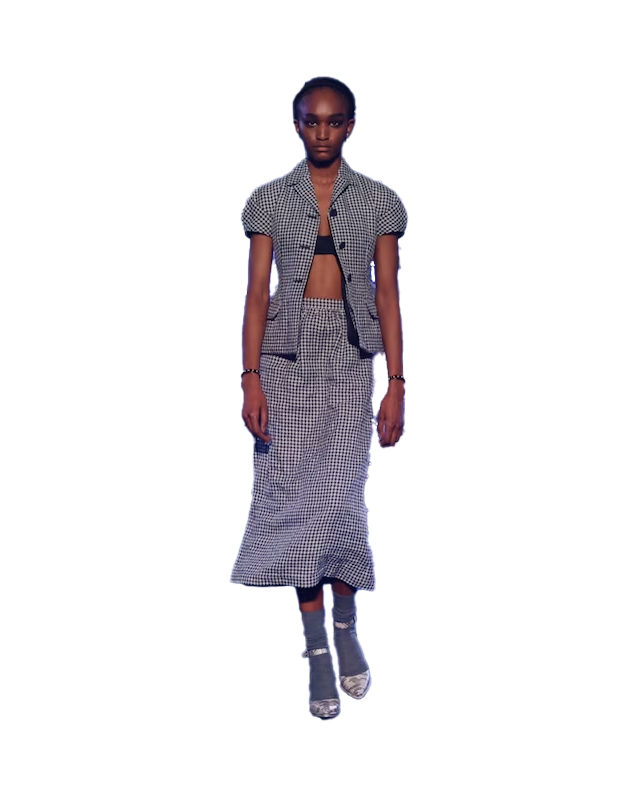
Crinkle cut
Dior’s short-sleeve gingham skirt suit with its mid-calf hem and crunchy techno cotton fabric can be rolled in a suitcase and will solve many a style dilemma. Inspired by chanteuses such as Juliette Gréco and Edith Piaf, Creative Director Maria Grazia Chiuri‘s AW23 collection tactfully strikes the balance of combining elegance and everyday ease.
Follow LUX on Instagram: luxthemagazine

A fine vintage
The tailored skirt suit with an echo of pure 1980s glamour comes back into its own this season. Bruno Sialelli delivers a powerful version for Lanvin with a strong-shouldered single-breasted jacket and button-through mid-thigh skirt in rich Bordeaux red. Dare to wear with tonal thigh-high boots to the boardroom and beyond.
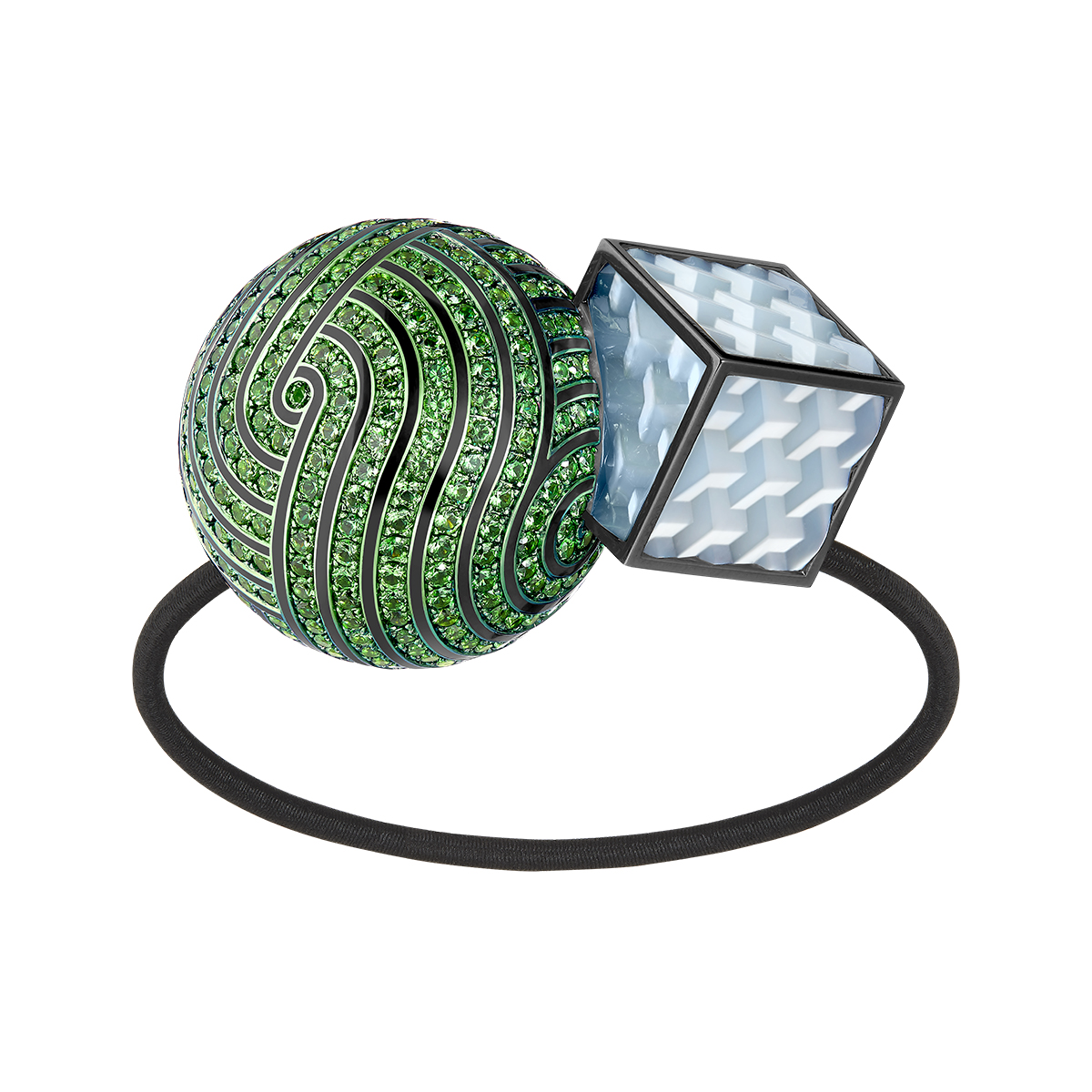
Blowing baubles
Boucheron Creative Director Claire Choisne channelled her love of the playful and unexpected in the new geometric High Jewellery collection, presented in Memphis-era boxing ring in the Boucheron private apartment in Paris. These sapphire and mother-of-pearl hair bubbles are set in lightweight titanium and are a spectacular way to decorate your ponytail.
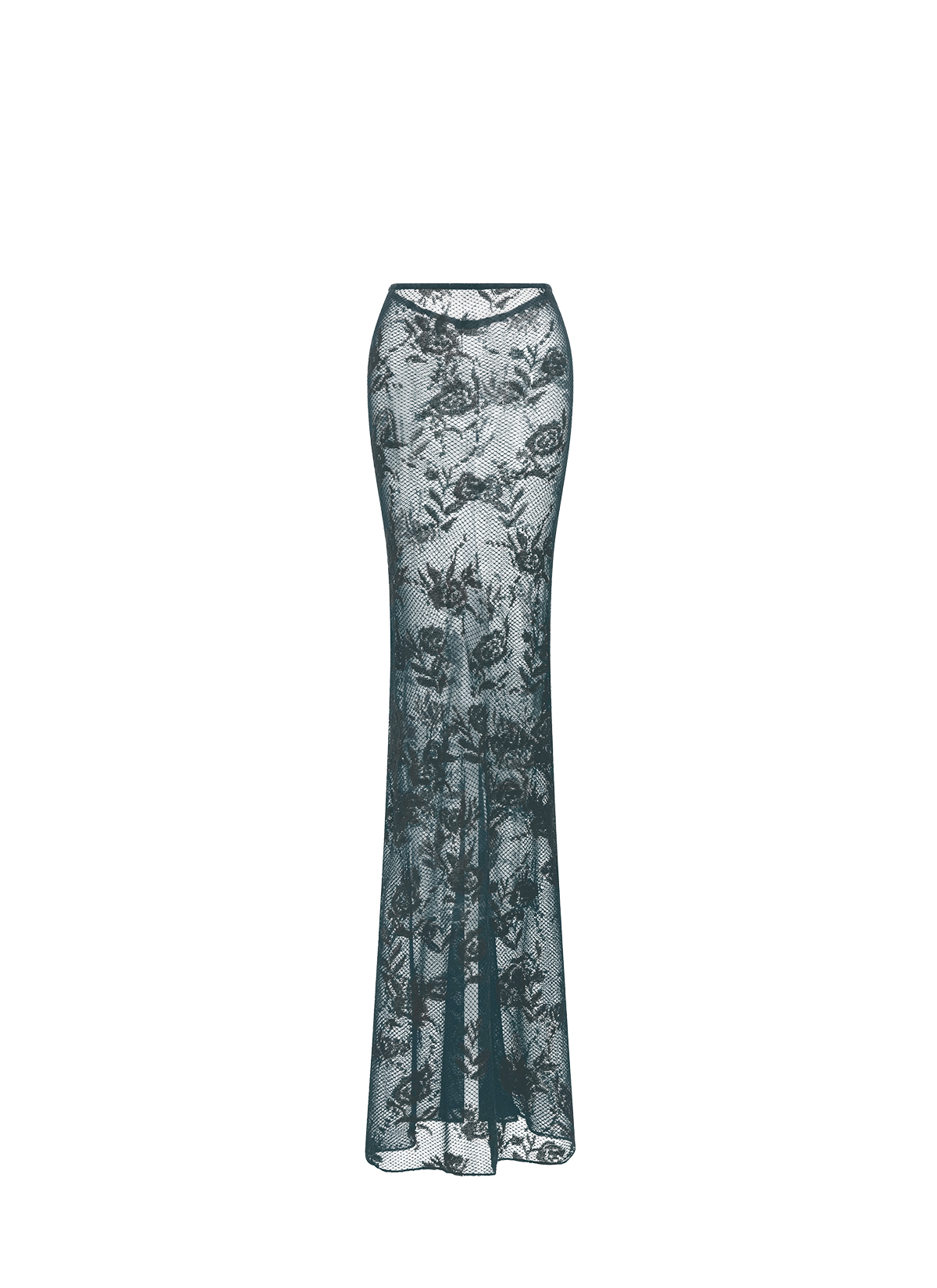
Reveal and conceal
Pieter Mulier, Alaïa’s Creative Director, excels in body-glorifying silhouettes and intelligent sexiness. This semi-sheer lace maxi skirt is juxtaposed with a silk-dupion hooded bodysuit for quietly powerful after-dark dressing. This season’s exposure is all about reclaiming the body and putting your physique directly on show.
This article first appeared in the Autumn/Winter 2023/24 issue of LUX
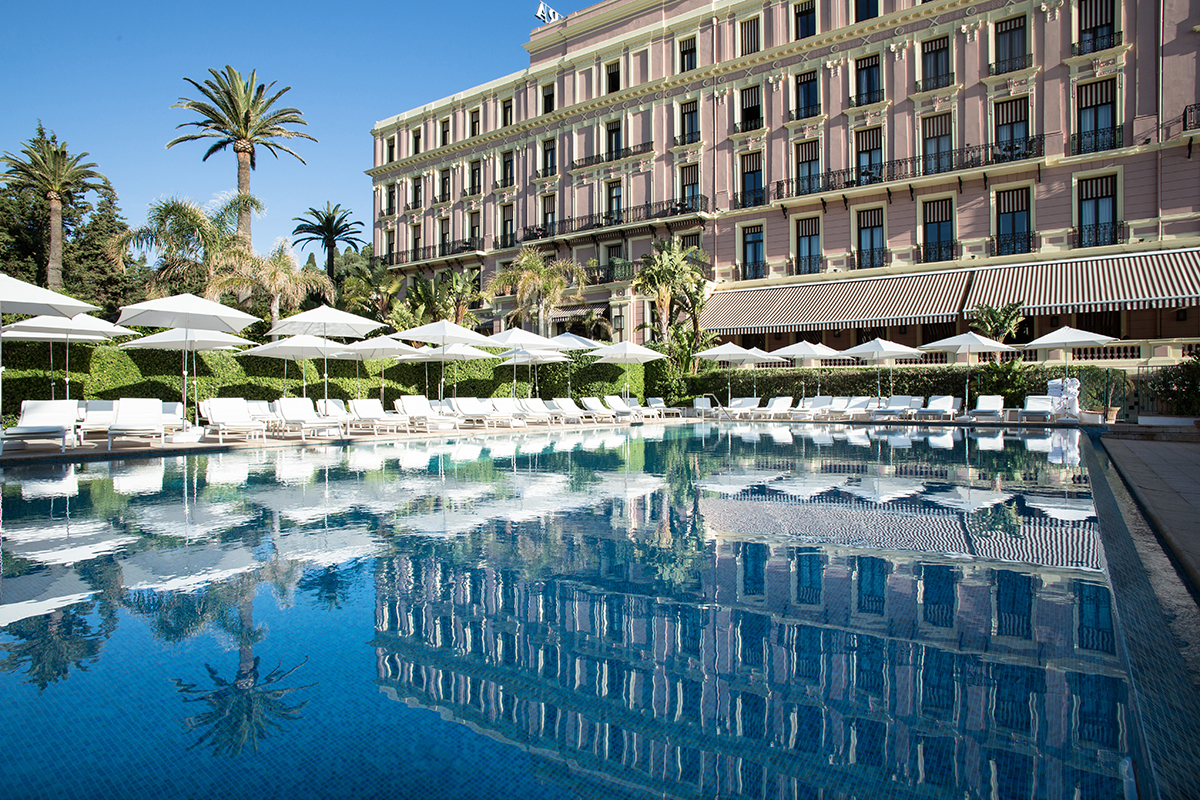
Belle Époque meets contemporary at the Royal-Riviera, Côte d’Azur
In the second part of our luxury travel views column from the Spring/Summer 2023 issue, LUX’s Editor-in-Chief Darius Sanai checks in at the Royal Riviera, Côte d’Azur
What drew us there?
Many of the great hotels of the French Riviera are places to see and be seen. They are the kind of destinations where wardrobe prep and social diary-checking can take as long as the stay itself.
Follow LUX on Instagram: luxthemagazine
Wafting through the understated reception of the Royal-Riviera, you realise you are somewhere quite different. Walk to the pool area behind the main Belle Époque building and there is a low-rise building, Villa l’Orangerie, that houses capacious rooms and suites; to your left is an elegant restaurant beyond which you see the Mediterranean stretch to Monaco. Behind the hotel is a dramatic vista of mountains plunging to the sea. Although the hotel sits in the most desirable residential area of the coast, this is an enclave, a place where you put on your Chanel sunglasses only to protect yourself from the sun. Your fellow guests are as discreet as you are; they don’t need to shout about who they are.

The perfect private terrace
How was the stay?
Our suite was in the Villa l’Orangerie, whose rooms and suites are all newly renovated, as is the terrace surrounding the swimming pool and the garden deck, giving us much to admire. We had our own little private garden and could go from our living room to the pool in 12 steps.
Sit by the pool and you won’t feel like leaving: the view of the mountains and the Mediterranean cuisine served poolside or in the restaurant see to that. If you do go out, this is super-prime Côte d’Azur. The village of St-Jean-Cap-Ferrat is five minute’s walk one way along a pretty coastal path. The centre of Beaulieu-sur-Mer – another chichi resort in this hallowed region between Nice and Monte Carlo – is five minutes the other way. Outside the hotel is a little sandy beach, a section of which is for hotel guests only. It is delightful and very different to some Mediterranean hot spots: no Instagram celebrities, just people chilling in one of the most spectacular parts of Europe.
Read more: One&Only The Palm, Dubai, Review
One afternoon, we took a taxi halfway up the mountain to the hilltop village of Èze, a medieval scramble of streets with unbelievable views in every direction. Another evening we went for dinner with friends in Monte Carlo, around 25 minutes away. In both cases, we were pleased to get back to the peace of the Royal-Riviera.

Discreet Mediterranean styling in a Junior Suite
Anything else?
Breakfast is on an arcaded terrace in the original building, where, later, a glass of vintage champagne sets you up well for the evening. From there, it’s a short stroll to the terrace of the Jasmin Grill & Lounge for a glass of Whispering Angel and a main course of grilled turbot.
Find out more: royal-riviera.com
This article was first published in the Spring/Summer 2023 issue of LUX
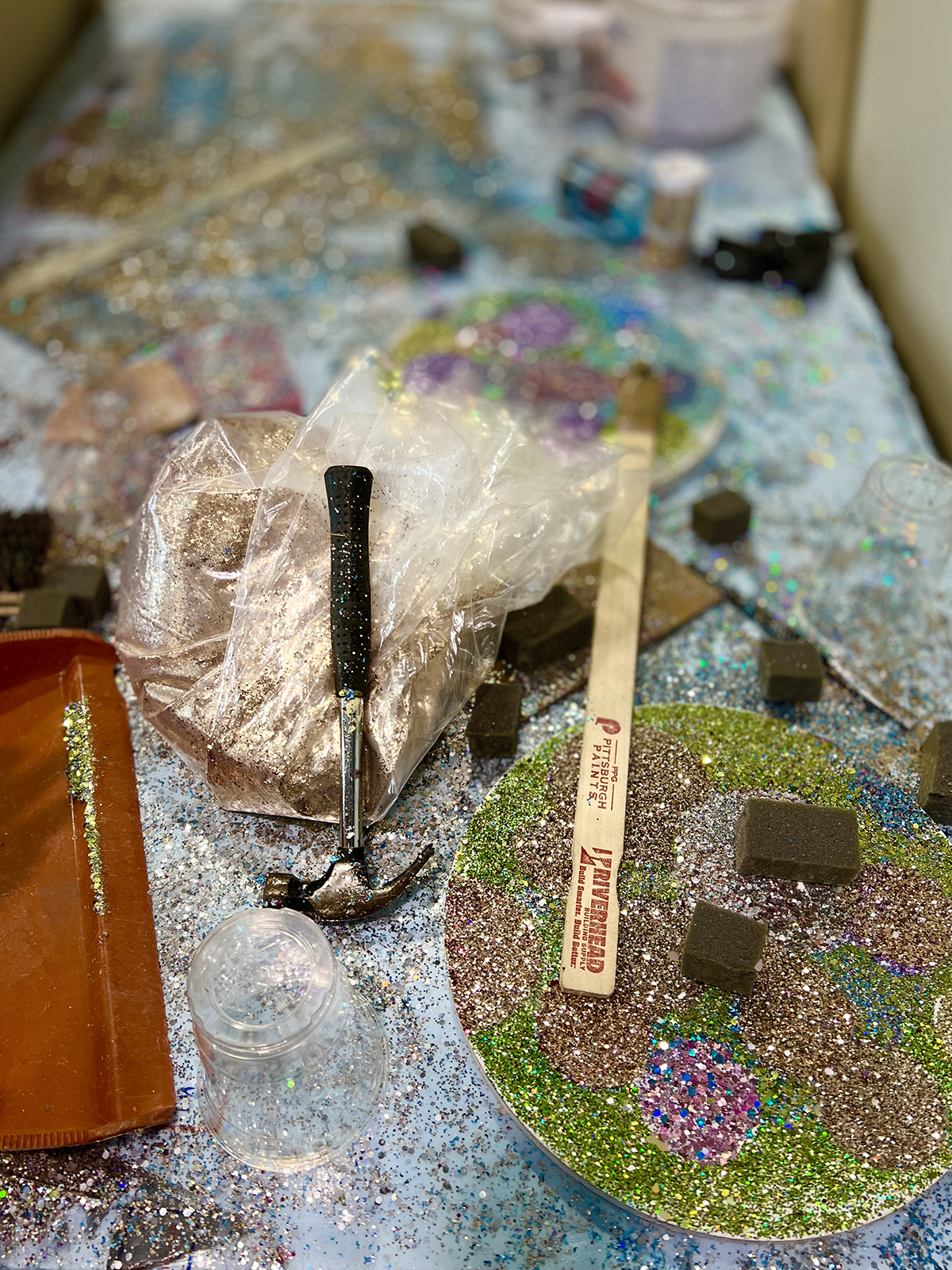
Studio detail with glitter tondo. Photo by Maryam Eisler
LUX’s Chief Contributing Editor, Maryam Eisler, visits Peter Dayton to photograph and interview the East Hampton-based artist at his studio. Here, Dayton speaks about the intention and ideas behind his artworks as well his relationship with Peter Marino and Chanel
Maryam Eisler: What lies behind the eye candy, the glitz and the glitter?
Peter Dayton: I feel like I’ve reached a kind of pinnacle where it’s just about incredible celebration. And, it’s interesting to me because I don’t always want to make work that looks really good. And somehow this glitter thing, which really shouldn’t have worked, is in fact working. By taking everything out of the picture including figuration, I feel like I’ve really got something that has a lot of meaning.
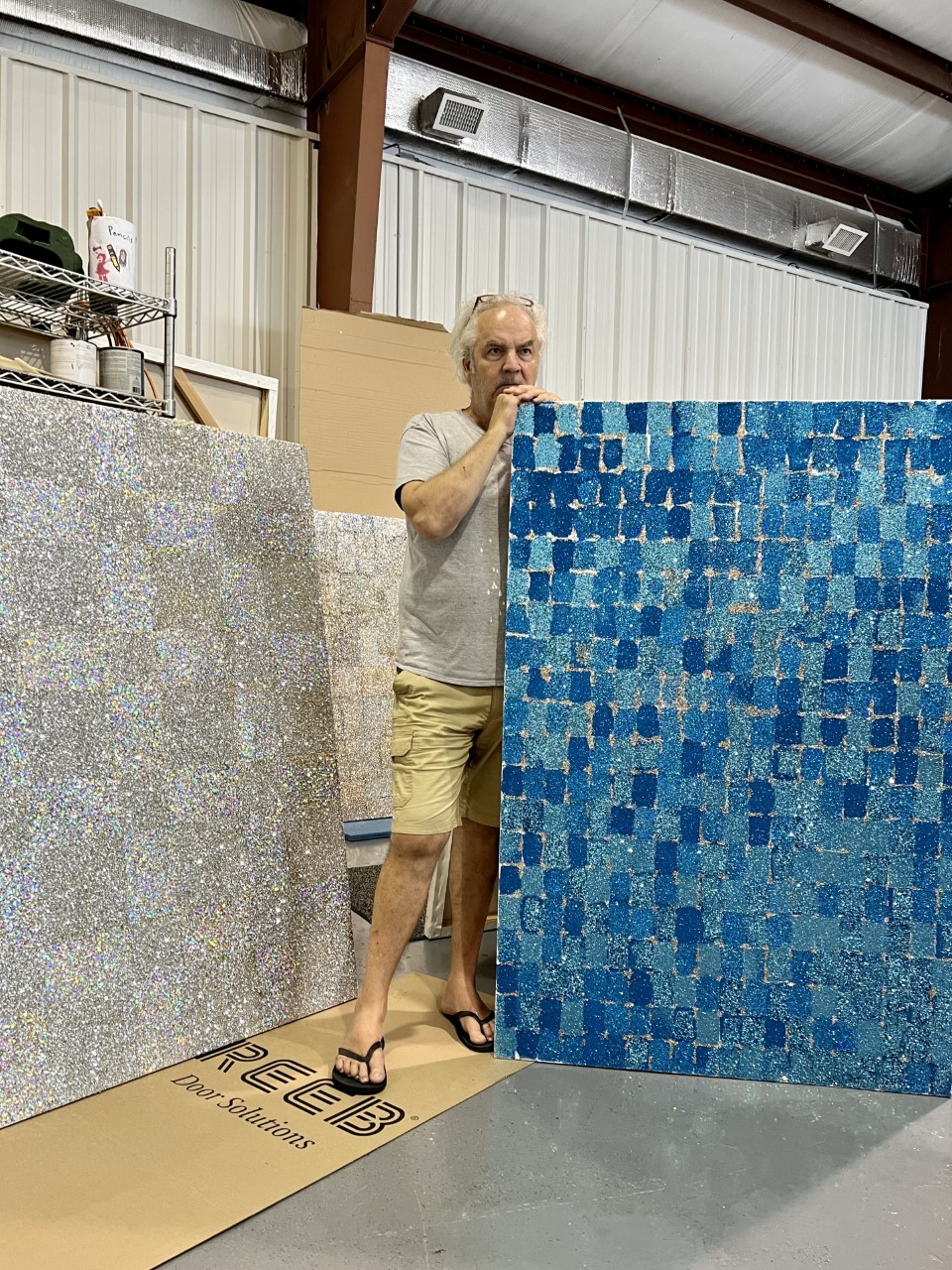
Right Blue Wave, 2022. Left Magic Carpet Ride, 2022. Photo by Maryam Eisler
ME: What’s even more interesting is that you are not staying shy of beauty, something we don’t see much of in the art world these days.
PD: We’re in a new art world. And, you know, to me, beauty is the law. I do it intrinsically. It just happens. I’ve always been a little left of centre because of that, and it just isn’t on the surface. It’s deep. Peter Marino saw immediately that I had a gift for this ‘beauty thing’ and he just took me under his wing. That’s how and why my association with Chanel has been so great.

The Rockets, 2016-2018. Photo by Maryam Eisler
ME: Has the act of ‘glittering away’ all day every day scared you in any way?
PD: It’s a little scary. Yes, because I’ve been spending the past 12 months just doing glitter and, you know, there are bills to pay. But I do feel like there may be a super happy ending to all this. Or, better yet, a happy beginning!
Follow LUX on Instagram: luxthemagazine
ME: I was taken by your choice of words and thought association; you said ‘It’s time for celebration!’ This is a positive outlook, also rare these days.
PD: Well, the negative is so real right now, but let’s face it, this isn’t like the bubonic plague. You know, I don’t want to intentionally make people happy, but I do want to give them a chance to choose happiness. So, I make these paintings. The time feels right for it.

Studio wall detail, Too Many Planets, 2022. Photo by Maryam Eisler
ME: I’m also interested in the idea of space and place. I know you’ve been coming out to the East End [of Long Island] since 1975 and started living and working here full time in 1988. Have things evolved a lot since then?
PD: Yes, there’s been a lot of evolution out here. On a personal level I got married and started a family. And East Hampton as a town has certainly evolved – it used to be dead in the winter. As an artist it was total evolution. I’d been studying art since I was 12 and then ditched art to play punk rock. I basically reinvented myself as an artist out here after living in Paris for couple of years making music.
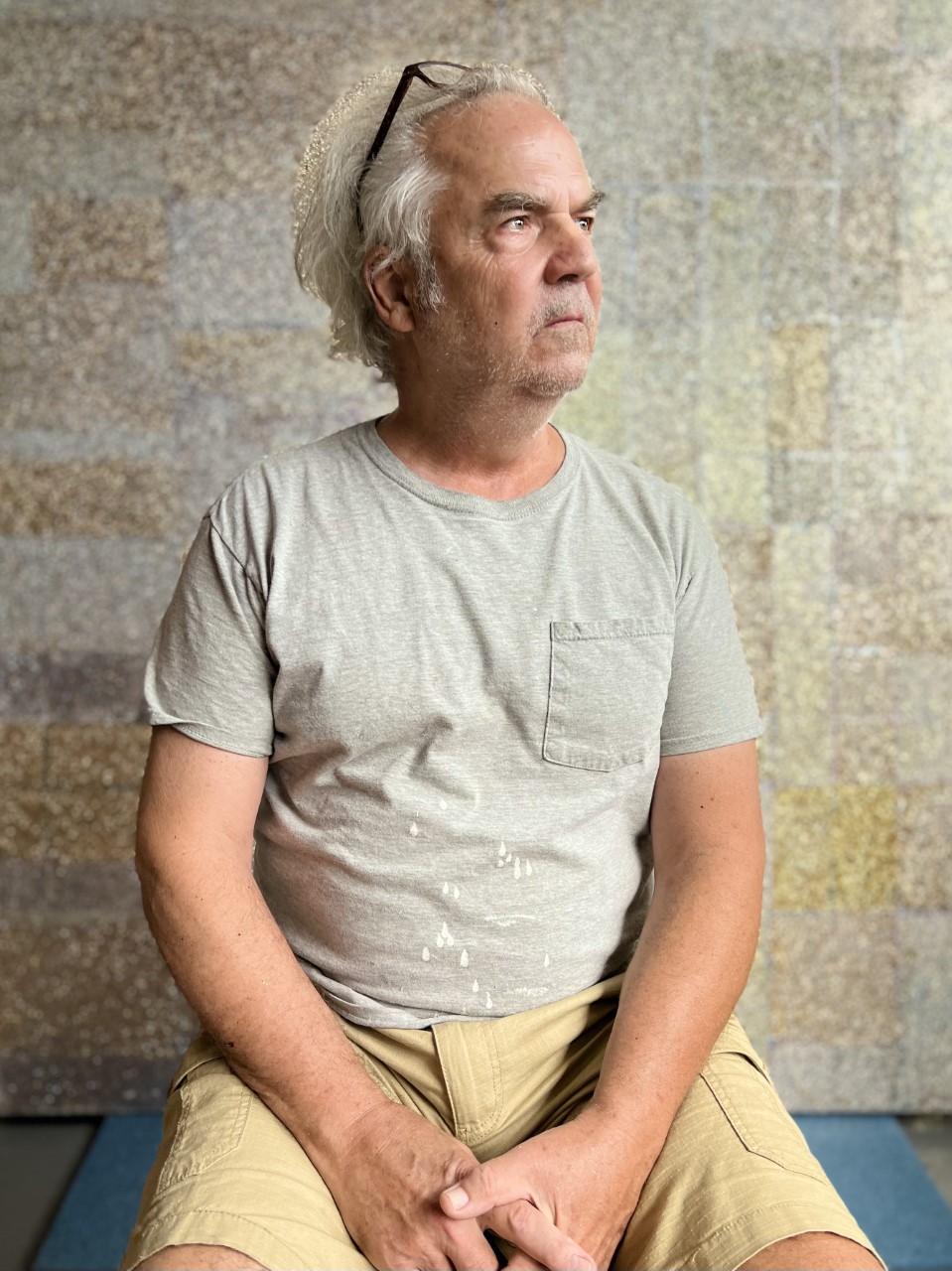
Portrait of the artist. Photo by Maryam Eisler
I also happen to love de Kooning, and I love Pollock; I love the idea of all that is anchored here- even before I was aware of all this, when my mother moved here all those years ago and when I started coming here from Boston where I was studying at The Museum School. I always thought, ‘my Lord, this place is beautiful.’ And then I understood the special light that’s out here. I think De Kooning called it ‘double light’. It relates to when the sun reflects off the water, back up into the sky! I don’t harp on it, but, you know, it is very important.
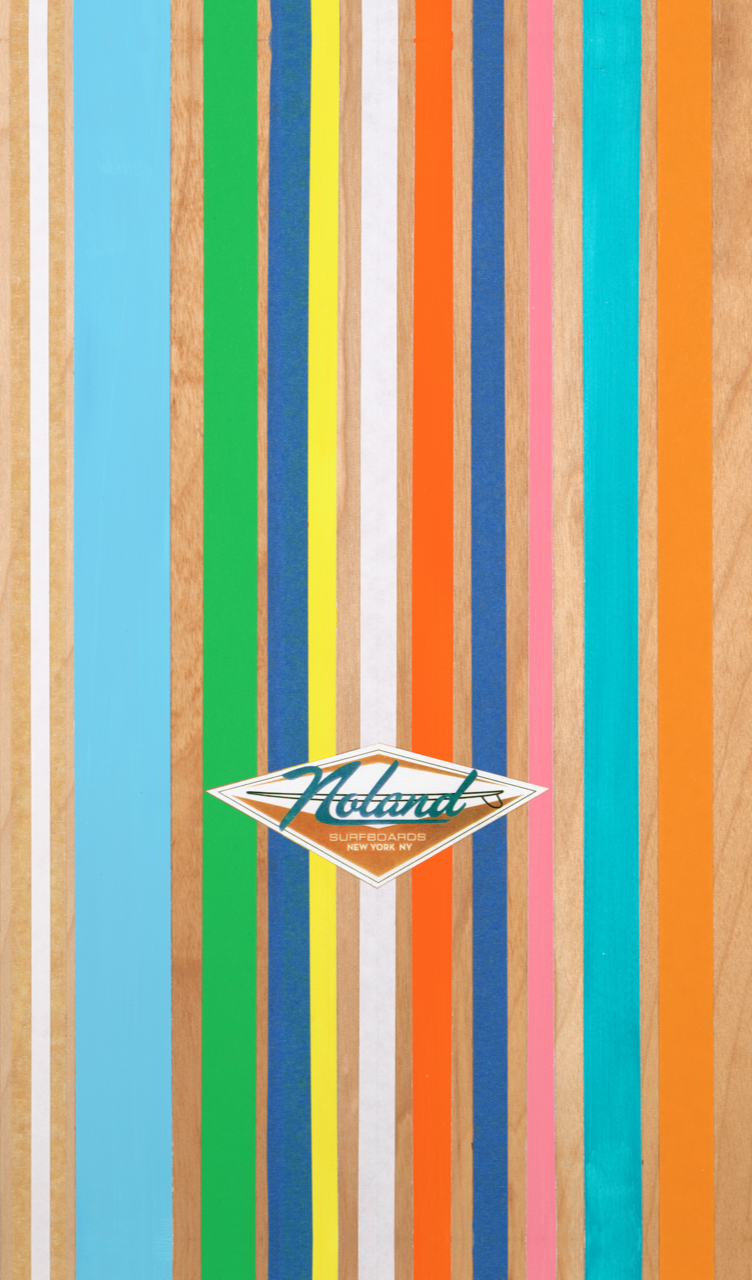
Noland, 2014
ME: In your work, I see surfboards. I see flowers. Where do they coincide?
PD: Good question! The flowers started because I had been doing music professionally for ten years, and then I burnt out completely. I went to Paris for six months to find myself and I stayed for three years. And it was fabulous. And I did find myself. ‘Myself’ was somebody who wanted to grow old in his studio, making pretty pictures – but pretty serious pictures too.

Too Many Planets, detail 2022. Photo by Maryam Eisler
The ‘flower’ phase started because I thought to myself, I missed the eighties. It happened by chance. There was a construction site behind my mother’s house. I saw a big dumpster. I went to the dumpster and I looked in. There were hundreds of House and Gardens from the 50s, and I thought, ‘Oh, wouldn’t that be so weird if I made flower collages out of old magazines and seed catalogues’? In a way it was this kind of totally ‘immature-ish’ thing you know, the kind of craft that grandma would do at the kitchen table. So I made one. And that’s when I first showed that work with Paul Morris in 1994 in Chelsea when the area was just starting. There was a really big splash about the work and it went really well. That’s also when and where I met Bob Colacello and where Peter Marino came in. Bob was so supportive right away. The show was more successful than I could have imagined.
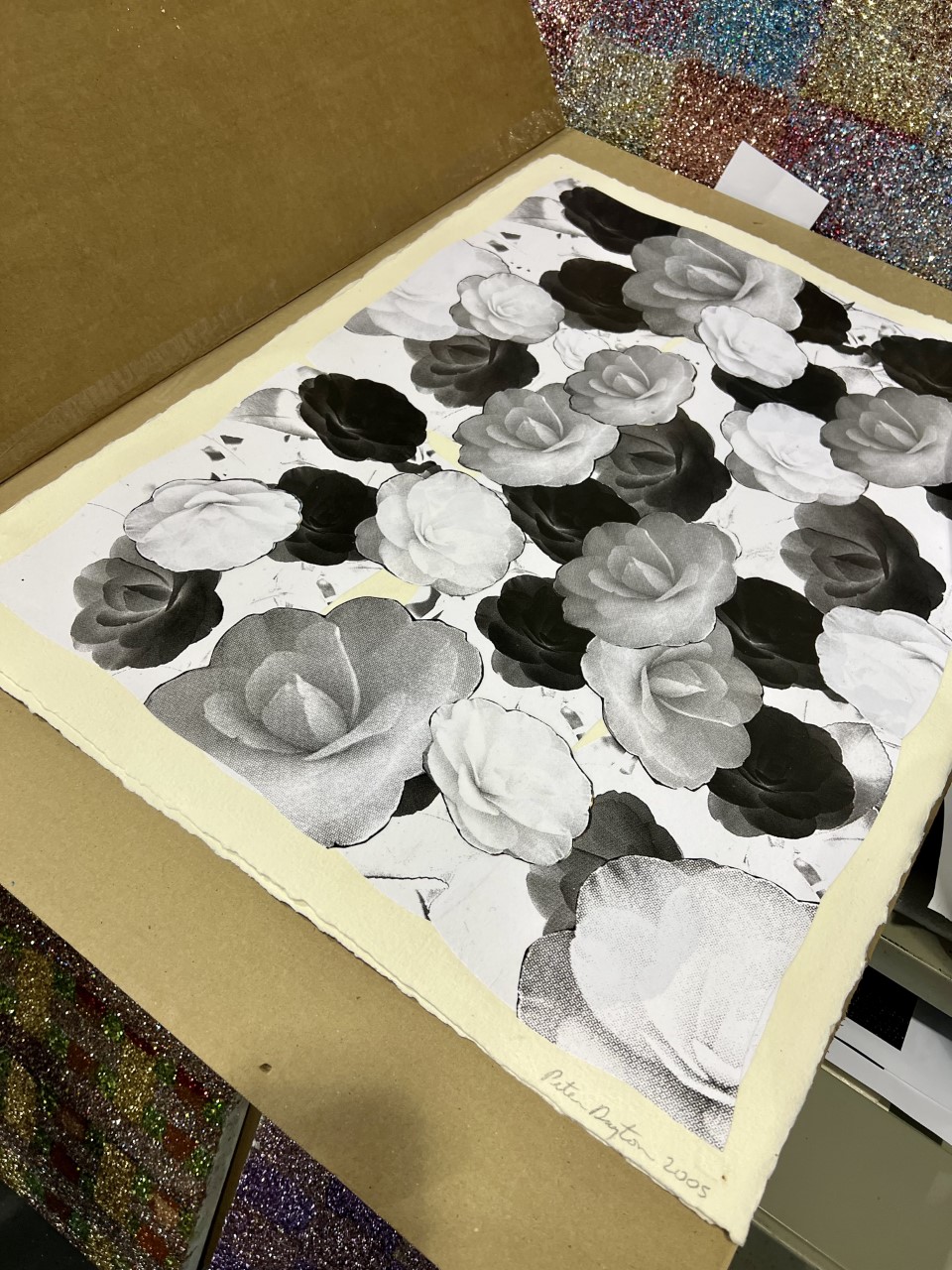
Camellias for Chanel, 2005. Photo by Maryam Eisler
ME: Historically, with the collages, there was a process of appropriation of others’ images which when rearranged, became your own. With these new glitter paintings, however, it’s your own hand at play.
PD: The cut-up method borrows. Taking pictures from a source that you shouldn’t be taking them from and turning it into something – in my case, into something that was weirdly beautiful.
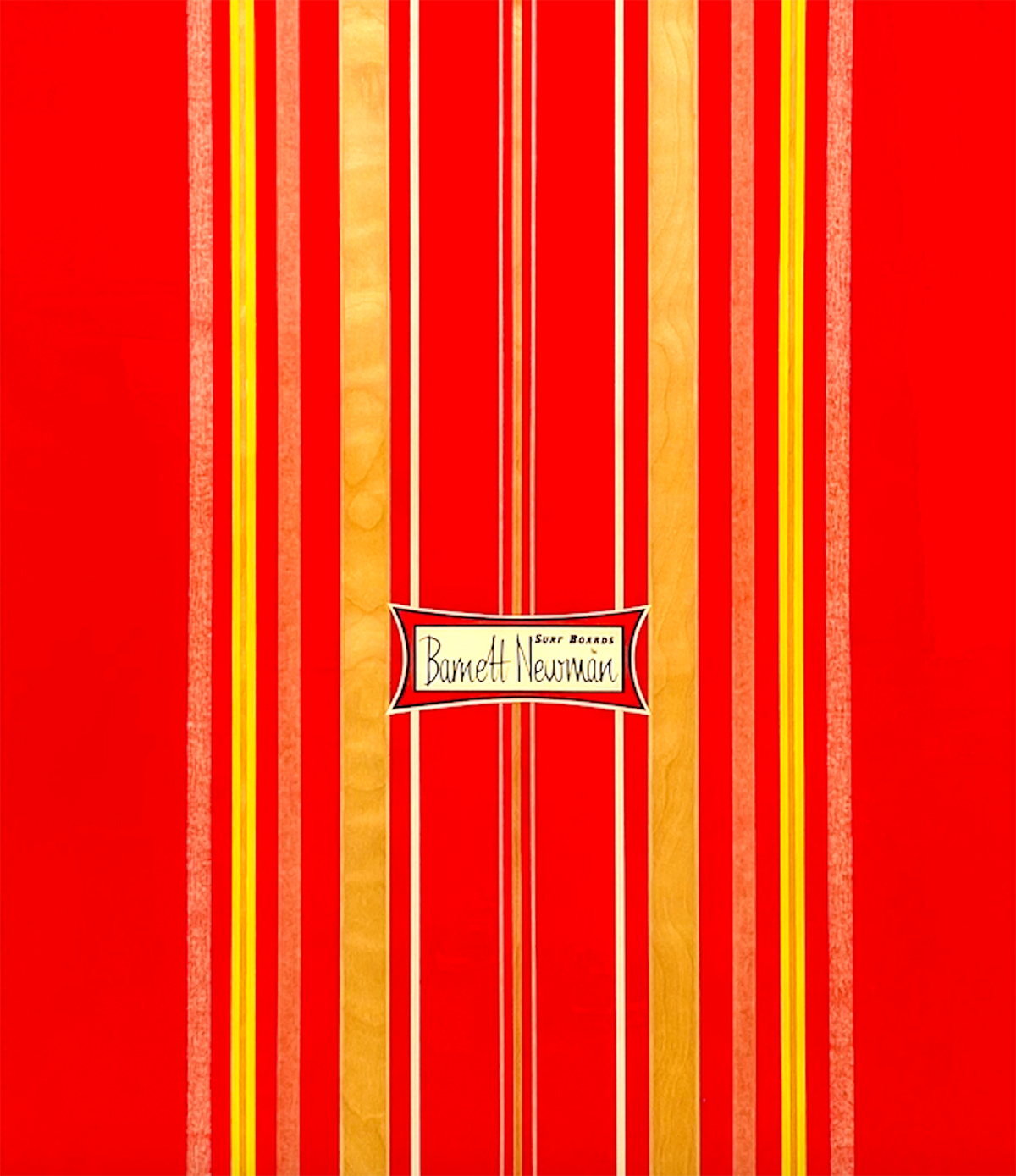
Surfboards by Barnett Newman, #4 New Generation
ME: And if it’s good enough for Chanel, it should be good enough for most! Tell me about your relationship with Chanel over the years.
PD: It’s been great. Peter [Marino] was collecting my work early on and doing things with private clients and for himself, too. He’s been supportive all the way. It must have been at least 12 years ago that he contacted me and said, ‘I want you to do the interior of the elevator for the 57th Street Chanel store’. And I’m saying,’ sure, I’ll do that’. So I made a map card of all these small Camelia collages. I showed that to him and that’s how he designed it. And then I did one in Beverly Hills. And I think that one is still going. I also did one for the Peter Marino Foundation recently, which is amazing as it’s permanent.
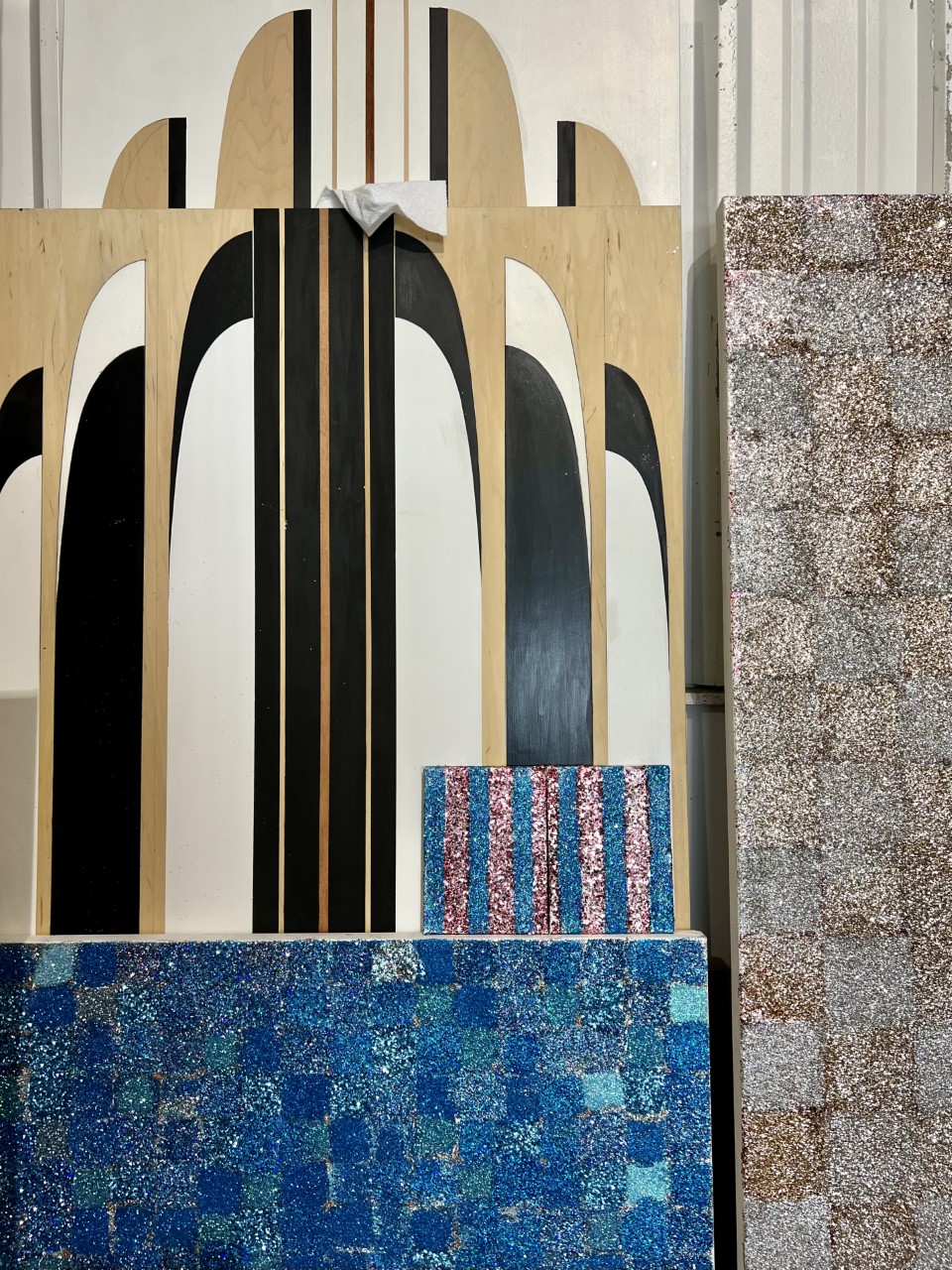
Studio detail, Northwest Coast Surfboards, and glitter paintings. Photo by Maryam Eisler
ME: It seems like you are highly influenced by the lifestyle of this area, in particular anything that has to do with surfing. You then associate your ‘surfboards’ with known art world figures. Please tell us more about this.
PD: I feel like all the artists from the early 50s all the way to pop art were acting with a lot of swagger and they were just doing these minimal paintings that were so challenging. And I have always equated them with surfers, those who go out there by themselves and ride these giant waves. So, I just put the two together. What they did was like a sport. And very physical. And there’s also the American cultural idea of surfing. I’m not a ‘surfer’ but I am a water person. I boogie board and belly board and all that stuff. There’s also that idea of great freedom in the water.
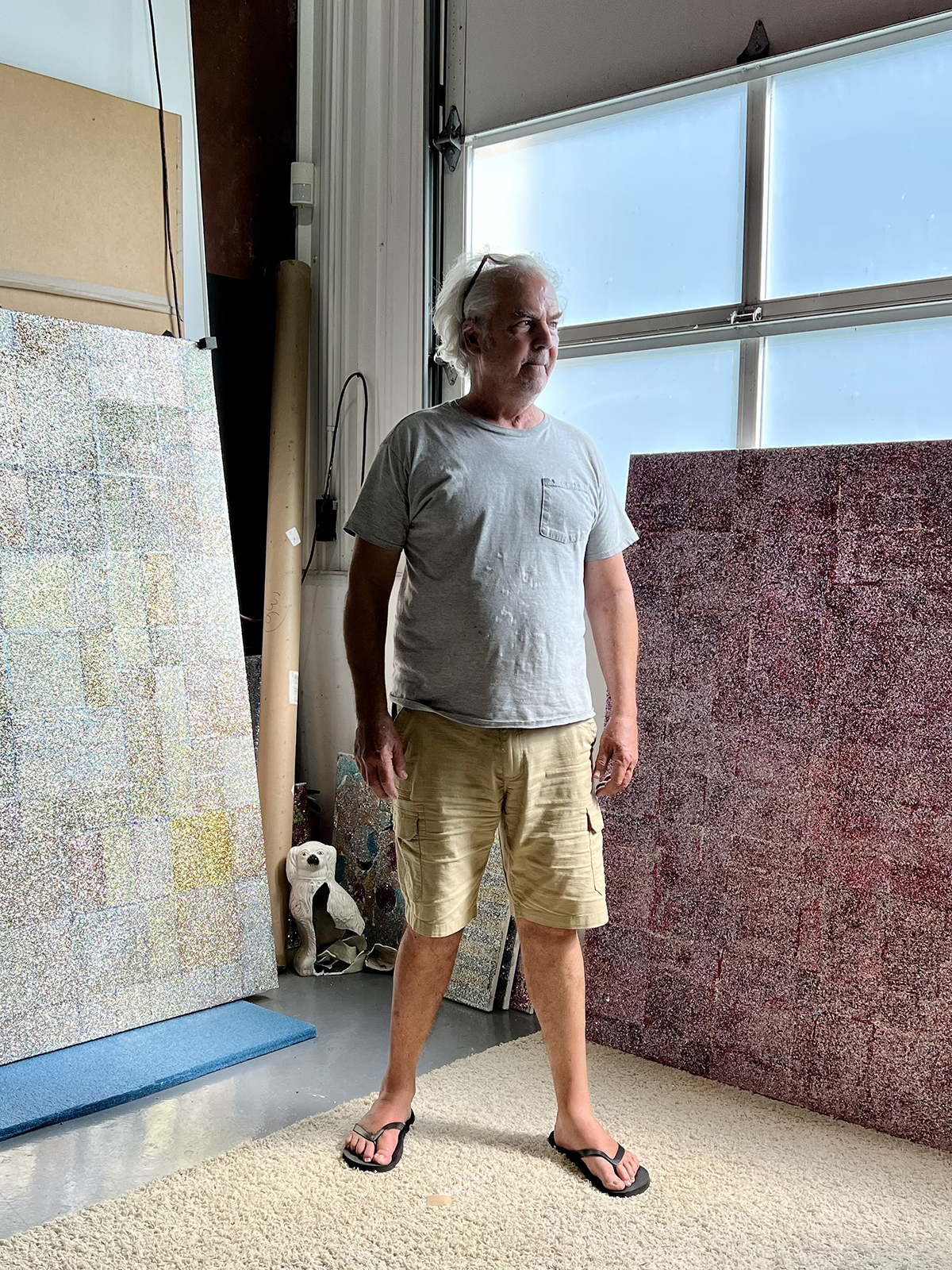
Portrait with glitter paintings. Photo by Maryam Eisler
ME: And it all started with Barnett Newman?
PD: Yes, when I saw his painting in the Met, ‘Concord’. There are two pieces of actual tape, which I think he left in the painting. But if he didn’t, he taped it off and pulled it off. I forget. And I said, ‘Oh, my God, that’s the stringer on a surfboard’. Because every surfboard in the centre has a piece of wood running through it for stability so it doesn’t snap in half easily; and I just found that fascinating. So, I went ahead and made one exact copy of the painting, kind of green, and put his name on it. And I remember Robert Rosenblum was alive then. And he said, ‘Boy, these are really odd, Peter. I kind of see what you’re doing, but I’ve never seen this before’. And I thought to myself, ‘Well it must be cool!’
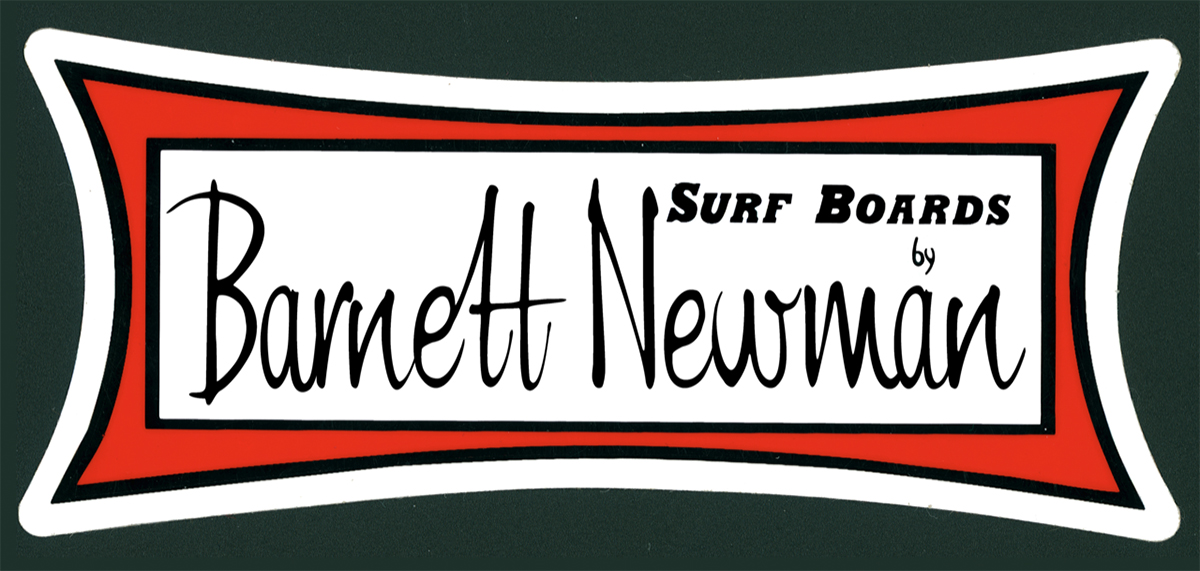
Surfboards by Barnett Newman, custom made decal, 2008
ME: Who are your other icons?
PD: Gene Davis. Which is the striped one, he did multi-coloured geometric stripes on canvas. I’ve also done Ken Nolan and Frank Stella. In all cases, I’ve done a facsimile of their works and superimposed their names into the actual surf decal. Dewey Weber is placed in the same script as Barnett Newman. So when a surfer sees that detail, he goes, ‘Oh my God, Dewey, Who’s Barnett Newman?’ Because I also equate the artists in their large studios in Soho all by themselves, smoking cigarettes, staring at these giant paintings with guys in California, making surfboards in their garages; they’re all kind of doing the same thing. Even though one is super high culture and the other is not, they’re kind of the same thing.
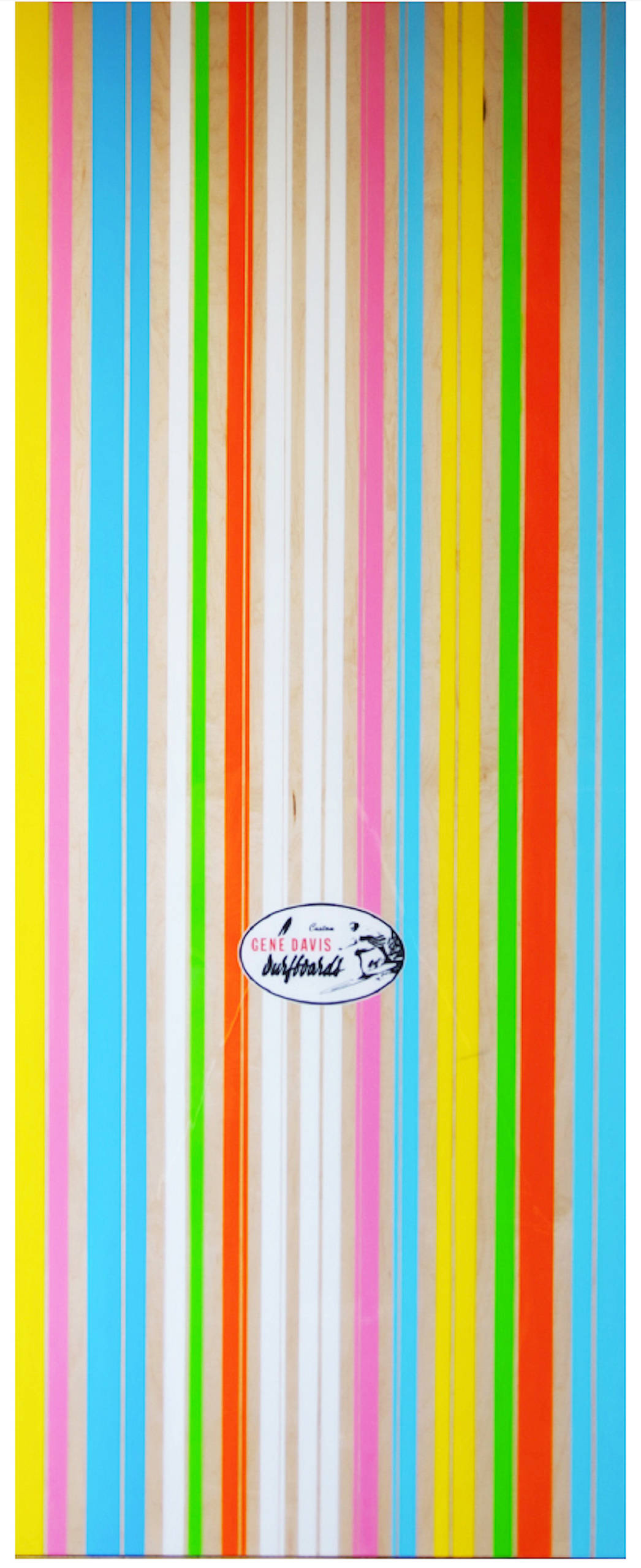
Surfboards by Gene Davis, 2007, collection Carl Bernstein
ME: But that’s what Warhol did- marry high and low culture so seamlessly.
PD: They come together. They always do.
Read more: An Interview With KAWS
ME: You were once part of this band called ‘La Peste’ out of Boston. Music is a different form of expression, but it’s still part of your own language, your identity…two complementary worlds, would you agree?
PD: Yes, I still have the guitar to prove it! And there’s great new interest in my band, maybe even a double album coming out next year on a label in Brooklyn. It’s really exciting. It’s been 45 years …
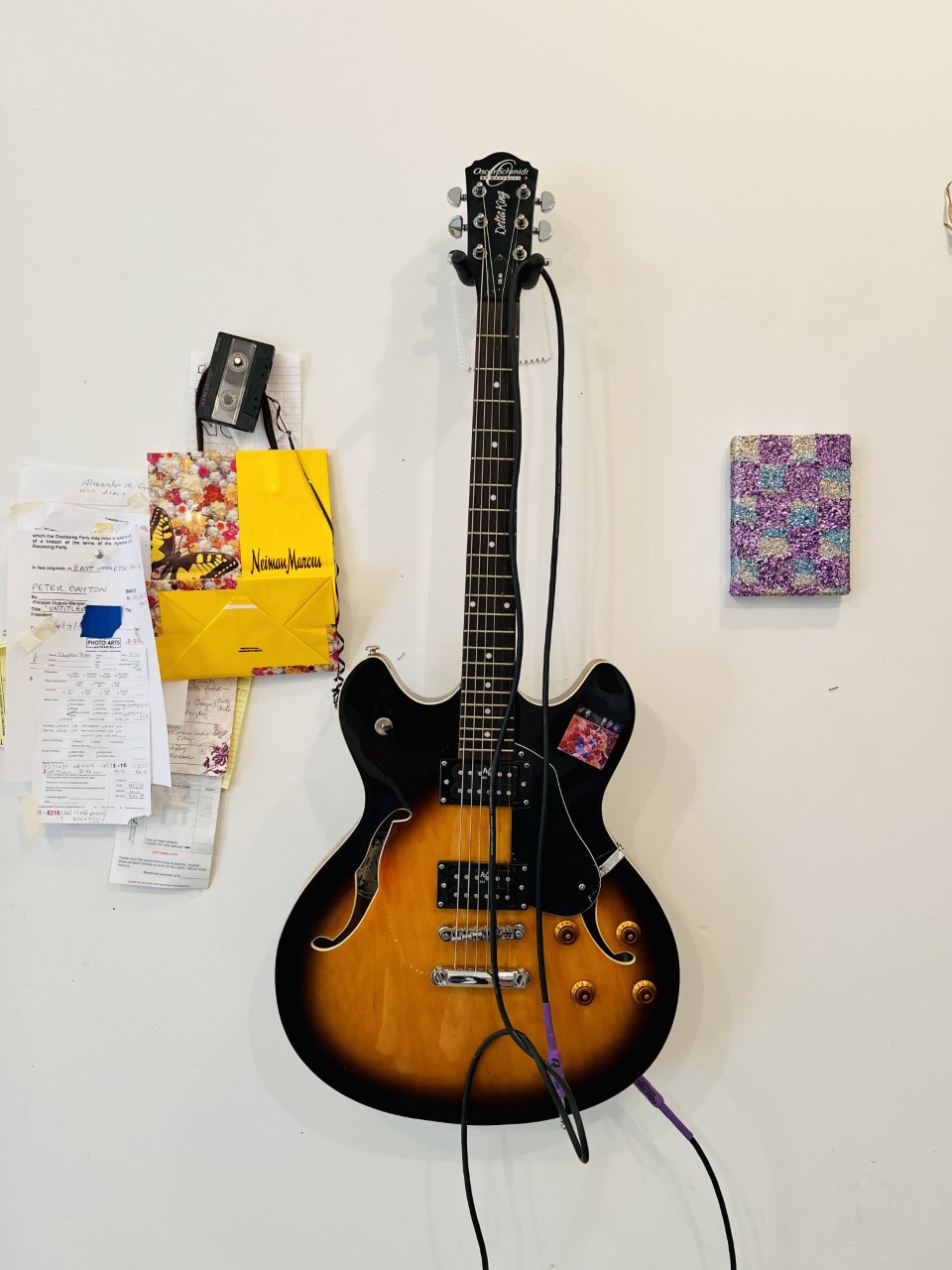
Studio Wall. guitar with glitter. Photo by Maryam Eisler
ME: Talk to me about your relationship with Peter Marino. He’s been a patron of your work.
PD: Peter’s a genius and it’s a privilege making work for his projects. He’s incredibly knowledgeable about absolutely everything that has to do with art, architecture, music – a total renaissance man. I’ve never met anyone who knows that much and can articulate it in front of you at any given moment. He’s a patron to a number of artists and his support has been so important to me. Working with him is great because he gives me great freedom to do what I want to do and that’s all an artist could ask for.

Studio work table with glitter and brush. Photo by Maryam Eisler
ME: A final comment from me: I could practice yoga in front of your paintings and just wonder with my eyes. Such serenity!
PD: Thank you. I think the glitter is here to stay, for the world to enjoy. Even though the refraction of light is so busy, there’s a certain calmness to it all. That’s probably what you feel. So I invite you to sit back, relax and lose yourself in it all day!
Find out more: peteredayton.com
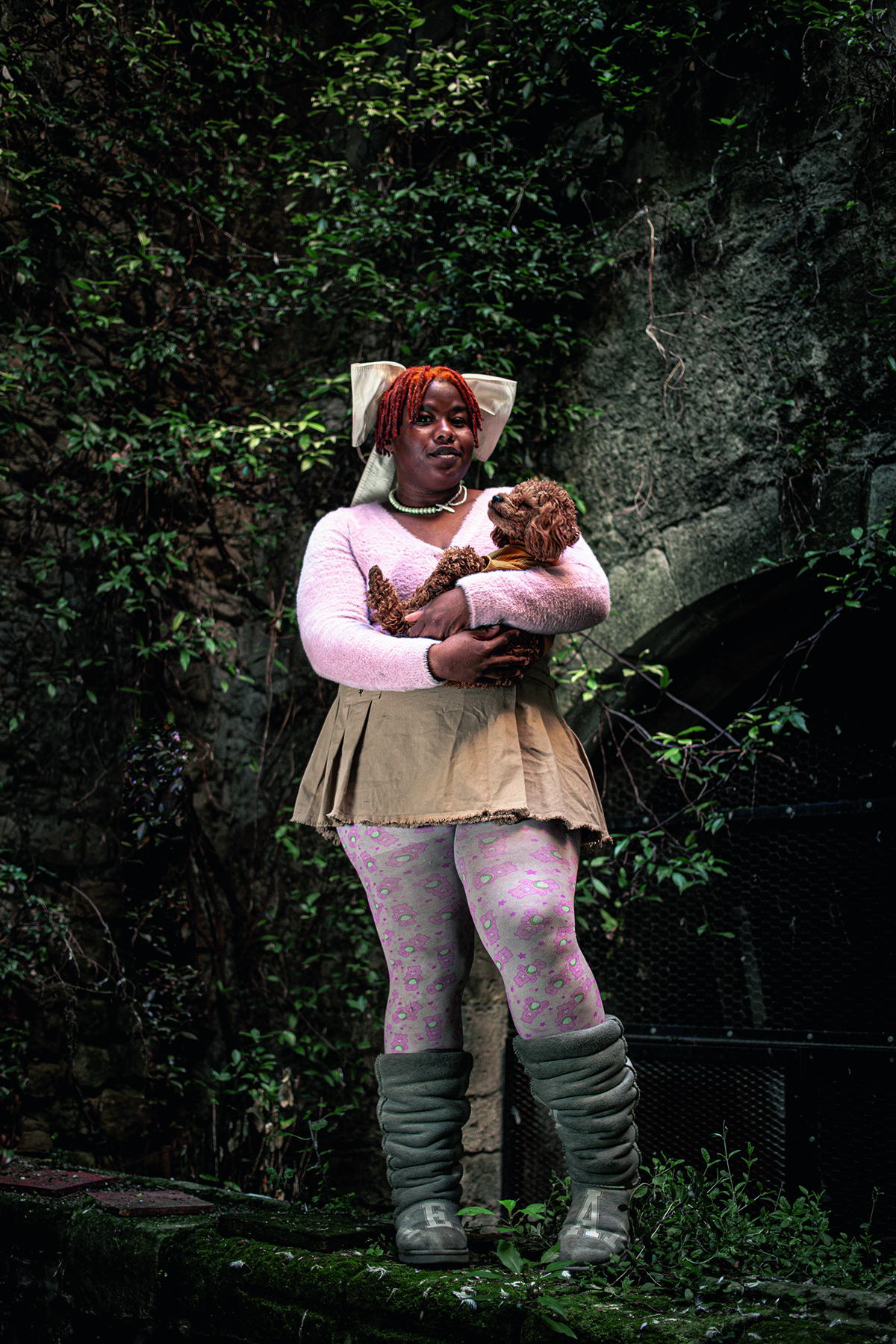
Precious Okoyomon and Gravity
LUX catches up with the New York-based Nigerian-American artist whose immersive installations portray the glorious chaos of nature – and its imperilment by the human race
1. You have been labelled as chef, artist, poet…
I think of myself as a poet. Everything else comes from there. Poetry is where I first found myself – in and within myself – and made something of it. Now, all the other things that I do, whether they want to or not, have to take the forms of poems. Everything is just a sort of non-stop poem at this point.
2. Where does your creative process begin?
Most things that I do start with reading. If not there, they come from just being in the world.
3. Do words ever fail you?
Everyday language fails and then we find each other sitting in the cracks of everything, trying to fall into the blur.

Okoyomon’s first solo show at the Luma Westbau, Zürich, in 2019
4. Can artificial intelligence create real art?
I’m not sure what real art is. If I did, none of this would be any fun.
Follow LUX on Instagram: luxthemagazine
5. Why does the kudzu plant appear so frequently in your work?
I love the vine. It’s been so special to have this extended collaboration with it over these past years. Some of the laws about cultivating it in the US actually made it very difficult to start working with kudzu. But now I know how to get around all of that and I feel like we have developed a real fluency with each other.
6. If you could switch off the internet forever, would you?
Definitely not. The internet is a part of me and you, and everything we touch. Please, no, never turn it off.

In ‘To See the Earth before the End of the World’ (2022), Okoyomon’s sculptures are set against a field of wild kudzu
7. What is your phobia?
I’m afraid of a lot of things, but I would never tell you what. You have to be careful with fear.
8. What talent would you like to have, that you lack?
I take ballet lessons, but I’m not any good at it. I wish I could do a fouetté.
9. Of all the cities you have lived in, which do you prefer?
Well, I love Paris. I love Arles even more, but I’ve never lived there. In short moments, I get the joy of getting to rest and make work in this special city, but maybe one day…

Okoyomon is the recipient of the 2021 CHANEL Next Prize
10. Who or what do you love right now?
Always my mother, my dog, Gravity, and [the Japanese figure skater] Yuzuru Hanyu.
11. Who or what do you hate right now?
I don’t like that question.
12. How will the Chanel Next Prize affect you?
I’m so grateful for the space it has afforded me to think without having to be afraid – and to just get to dream and play. I’m not sure how it will change the way I make things yet, but I’m so excited to get this rare chance to just explore. I really can’t imagine anything more magical.

Okoyomon’s installation, ‘Every Earthly Morning the Sky’s Light touches Ur Life is Unprecedented in its Beauty’ (2021-22), at Aspen Art Museum
13. Louvre or Pompidou?
14. St Tropez or Hackney Wick?
Neither.
Read more: Marina Abramović: The Artist As Survivalist
15. Have you bought an NFT?
No.
16. What’s your favourite building?
The Hayden Planetarium [in New York].
Precious Okoyomon was recently awarded the Chanel Next Prize and won the 2021 Frieze Artist Award
This article appears in the Summer 2022 issue of LUX

A look from Area’s AW16 collection, incorporating an official collaboration with Swarovski. © Swarovski Corporate Archive
Austrian crystal-maker Swarovski celebrates its 125th anniversary this year with a new creative director in charge. Operating in sectors from infrastructure to telescopes, it is most famous for its crystal figures and collaborations with the entertainment and fashion industries. Ahead of a landmark book being published about the company, Harriet Quick explores a family-owned firm getting ready for the next 125 years
For a brand bringing sparkle to the world’s performance stage and symbolising the dazzle of fashion to be celebrating its 125th anniversary is some achievement in itself, given the changes in the world of entertainment and style since 1895. To be doing so as a family-owned company, run in part by descendants of the original founder, is even more so. But for Swarovski, provider of crystals and sparkle around the world, there is yet another dazzling fact: the company has done so not based on the rue Faubourg Saint-Honoré or Milan’s Golden Triangle, but from a small village in the Austrian Alps.
Follow LUX on Instagram: luxthemagazine
The journey has been epic. Today, the company is managed by the fifth generation of its family members. This year, marking its 125th anniversary, has witnessed big changes. On the visual front, Italian-born fashion director and consultant, Giovanna Battaglia Engelbert has joined the company as worldwide creative director. The stores, a feature of cities and airports around the world, are scheduled for a sweeping revamp.
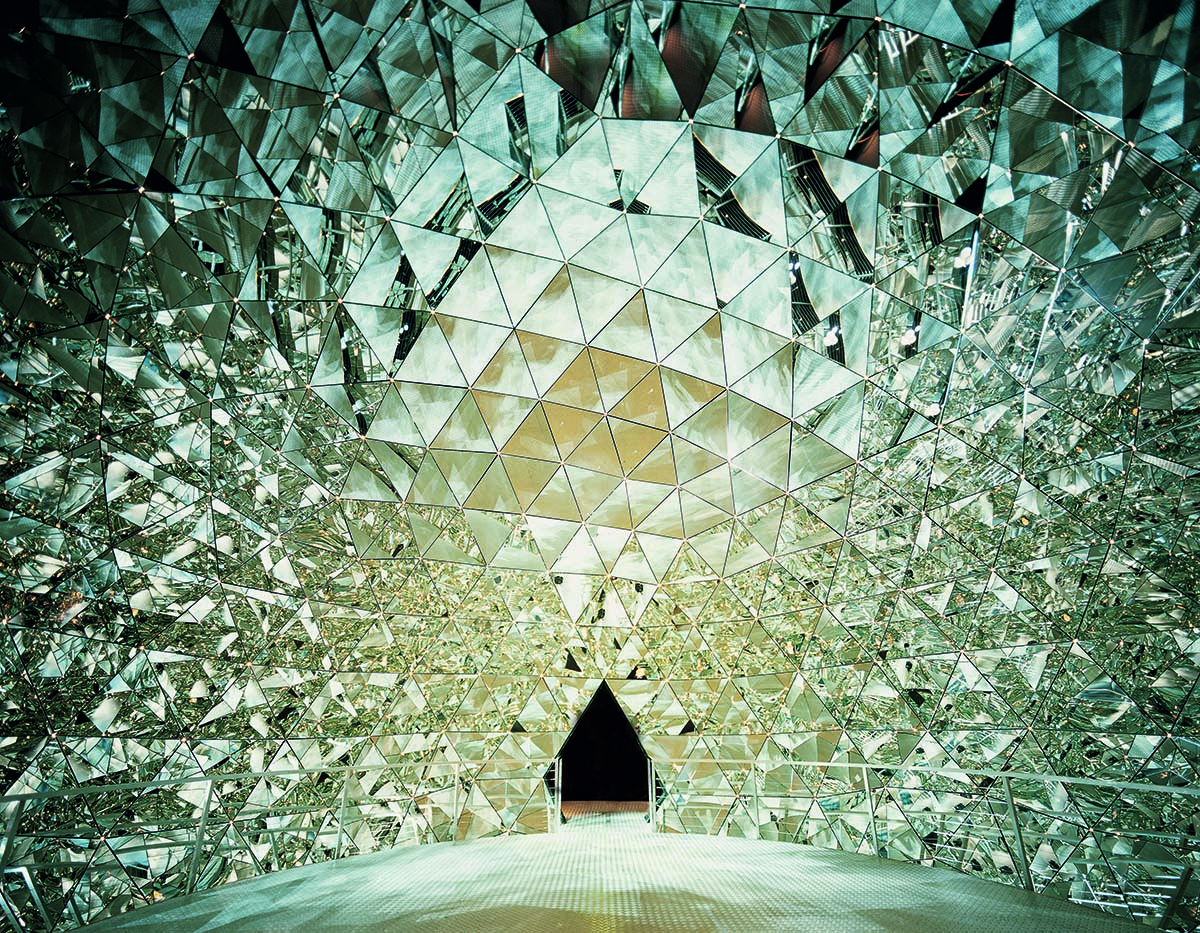
The Crystal Dome at Swarovski Crystal Worlds in Wattens, Austria. © Swarovski Corporate Archive
The brand’s history is as varied as the topography of the Austrian Tyrol where Daniel Swarovski set up his manufacturing plant in the town of Wattens to benefit from the abundant water source that powered the hydroelectric cutting machines. The mountains and valleys of the region are symbolic of the struggles and triumphs of a business that has been driven by the continuous merging of technology, nature and innovative design. There is a generous sprinkling of magic, too. It is embedded in the multifaceted crystals that never fail to arouse awe and around which there has been ample myth-making.

Daniel Swarovski with his family, c. 1890. © Swarovski Corporate Archive
Before the global pandemic, Swarovski’s annual turnover was recorded at 2.7 billion euros and that comprises revenues from its high-end fine jewellery creations, the crystal stones deployed by a whole array of creative minds, including costume designers, chandelier makers and architects, and optics. The lion’s share (75 per cent of the revenue) is generated by fashion jewellery, sunglasses, watches, perfume and the much-adored crystal figurines. The quality of the crystals that are prototyped at Manufaktur, the striking in-house laboratory in Wattens designed by architectural firm Snøhetta, is unparalleled.
Read more: How Andermatt Swiss Alps is drawing a new generation of visitors
The company’s extraordinary creative output has also been bolstered by a roster of collaborators from the fields or architecture, design, fashion, film and stage who have continually brought ideas and seemingly impossible challenges to the company, from the mesmerising Aurora Borealis crystal that was developed by Manfred Swarovski for Christian Dior to the spectacular costumes made for performers including Maria Callas’s gowns, Liberace’s capes and Lady Gaga’s bespangled Ralph Lauren gown featuring 50,000 stones and worn at her Las Vegas residency in 2019. People come to Swarovski for the spectacular and the sublime, like scenic designer Derek McLane, who used 45 million Swarovski crystals for the 2018 Oscars ceremony, and who commented, “I always want to go beyond the clichés”.

Swarovski crystals in jewellery featuring in 16 Arlington’s AW20 collection. © Dan and Corina Lecca.
From the fields of design, Daniel Libeskind, Tord Boontje, Jaime Hayon and John Pawson are amongst the greats who have transformed crystal into products, architectural features and lighting. Hayon recently designed a full-scale carousel for the Swarovski Crystal Worlds culture park in Wattens. The monochrome attraction rotates in striking juxtaposition with the lush greenery of the garden and shimmers with 15 million Swarovski crystals across 12 ceiling panels and 16 wall panels illuminated by a warm light. “For me, a carousel can be seen as a moving museum,” explains Hayon.
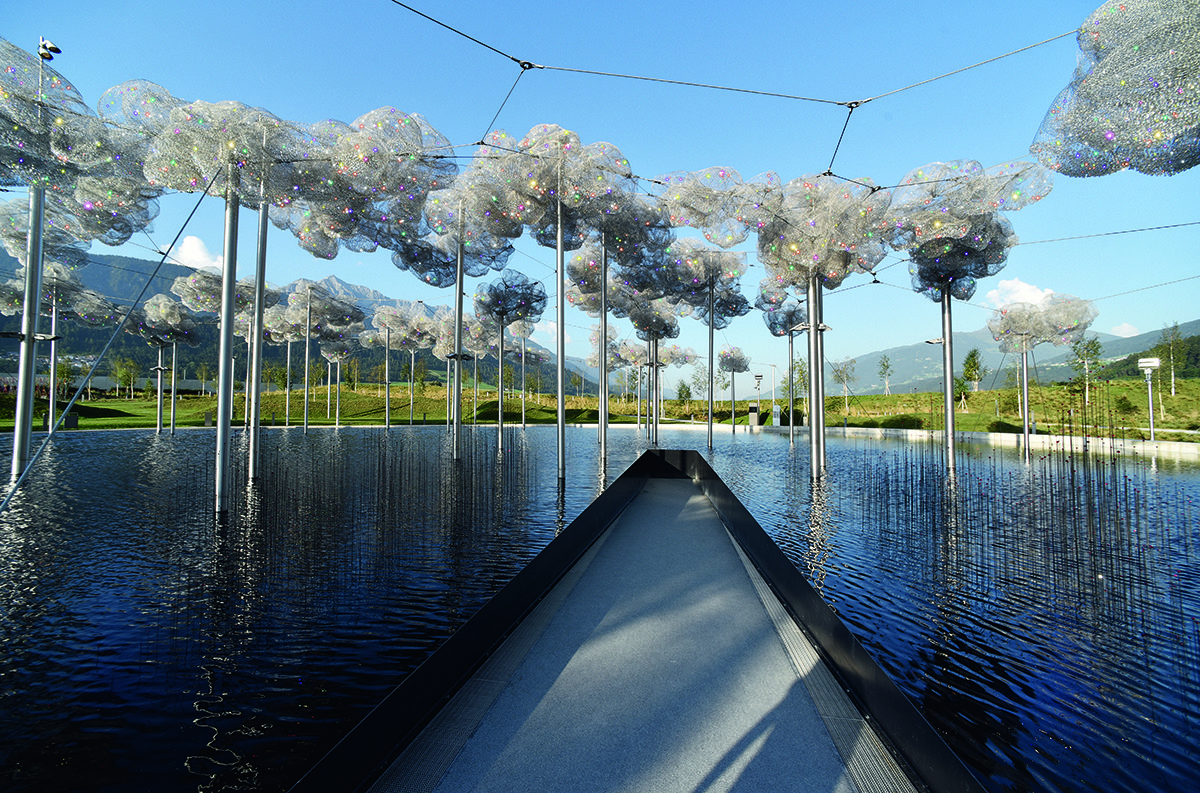
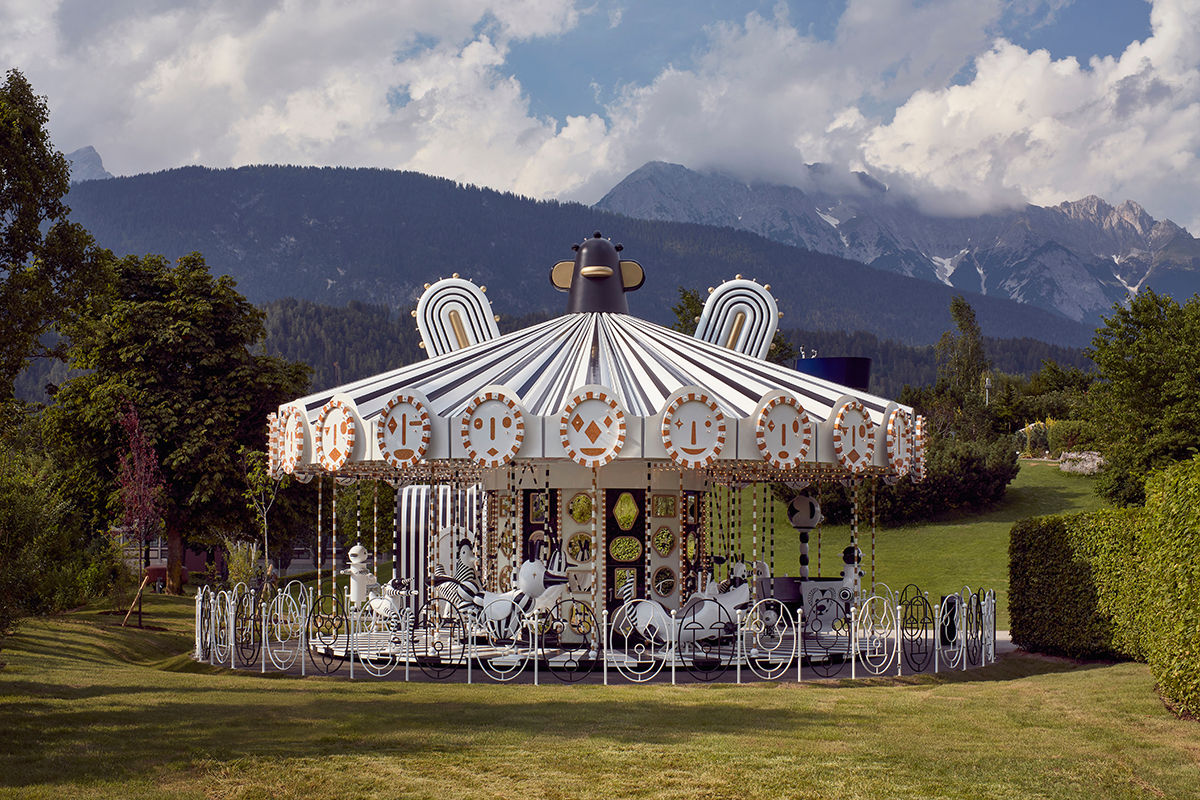
Swarovski Crystal Worlds, with (top) Crystal Cloud by Andy Cao and Xavier Perrot, and (here) the carousel designed by Jaime Hayon © Swarovski Kristallwelten/Mark Cocksedge
Setting a precedent that would inspire future generations, Daniel Swarovski first made his inroads into the worlds of high fashion in Paris. Equipped with suitcases of stones, the founder would take his goods on the road, visiting couturiers including Charles Frederick Worth, Jeanne Lanvin and Jeanne Paquin, as well as the specialist artisan ateliers that supplied Chanel and Schiaparelli with exceptional embroideries, buttons and jewelled adornments. Relationships were forged that outlived the founder and expanded exponentially during the hey-day of couture in the 1950s, attracting Dior, Balmain and Givenchy. “The samples are often the springboard to the creation itself,” remarked Hubert de Givenchy.
Read more: British artist Hugo Wilson on creating art from chaos
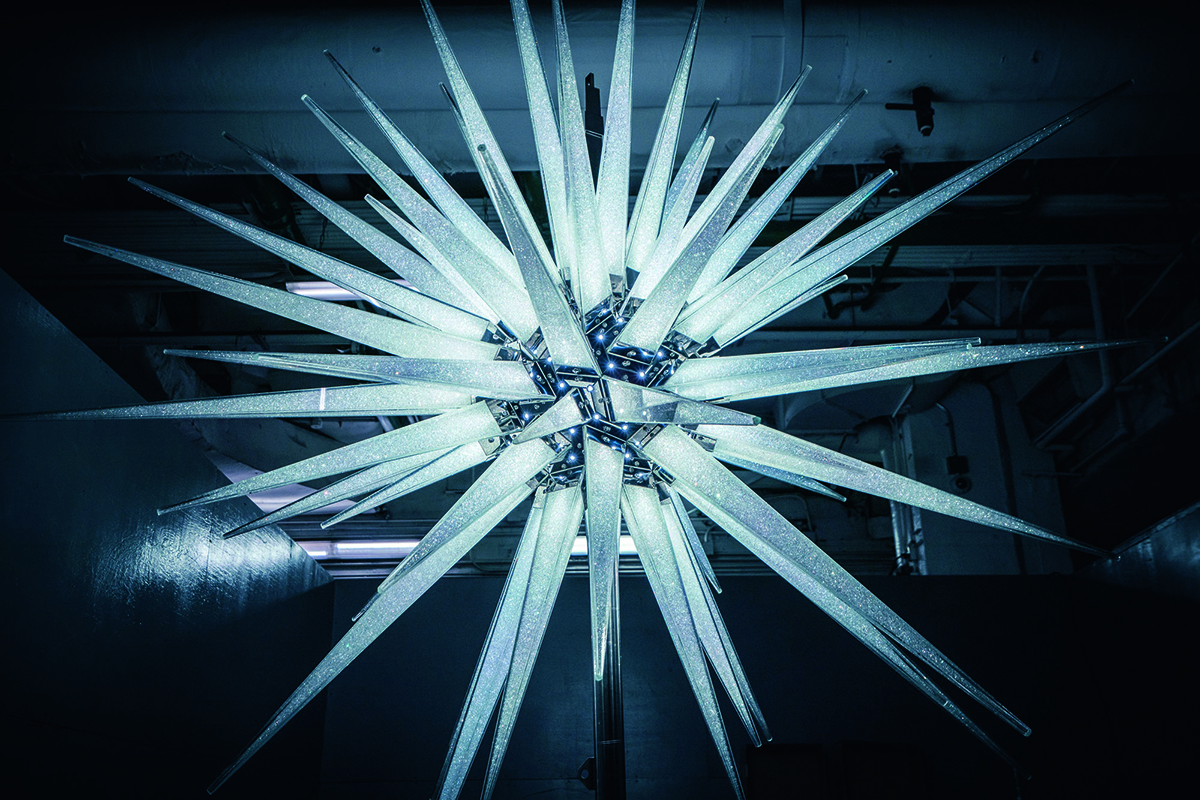
The Swarovski Star by Daniel Libeskind in 2018 for the Rockefeller Center Christmas tree, New York. Image by HappyMonday
Swarovski crystal became a desired material in fashion, adding glamour and value to evening gowns, heels, handbags and costume jewels. It has been endlessly interpreted through the changing waves of minimalism, maximalism, sportswear, theatrical and romantic moods and proved itself a classic. At Versace, Donatella has made crystal chain mail a signature, Miuccia Prada has made sparkle an integral part of her chandelier earrings and party dresses, while at Chanel, crystal is woven into the tweeds and classic costume jewellery.
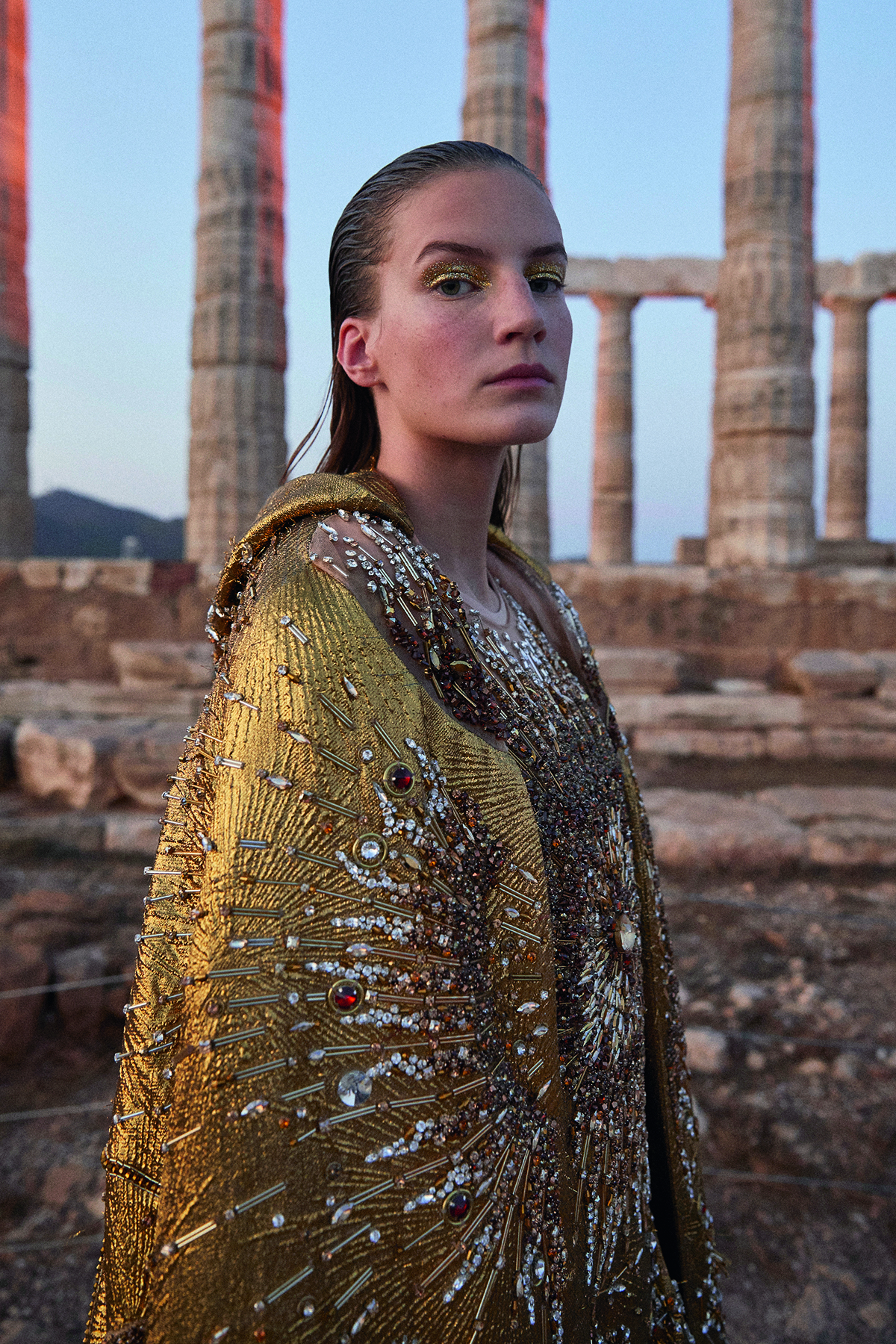
Mary Katrantzou’s SS20 show at the Temple of Poseidon in Greece.
The brand continues to look to the future by investing in new talent and ideas. Sponsorship through the Swarovski Collective programme and graduate award schemes means that emerging creatives are exposed to the potential of the material. Mary Katrantzou, Grace Wales Bonner, Rodarte and Jason Wu are amongst the many who have grown up through the collective. The most famous collaborator is Alexander McQueen, who conjured up brilliant designs fused with narrative richness and theatrical impact. Fittingly, Swarovski was the key sponsor of the record-breaking exhibition ‘Savage Beauty’ (2011) that celebrated his life’s work.
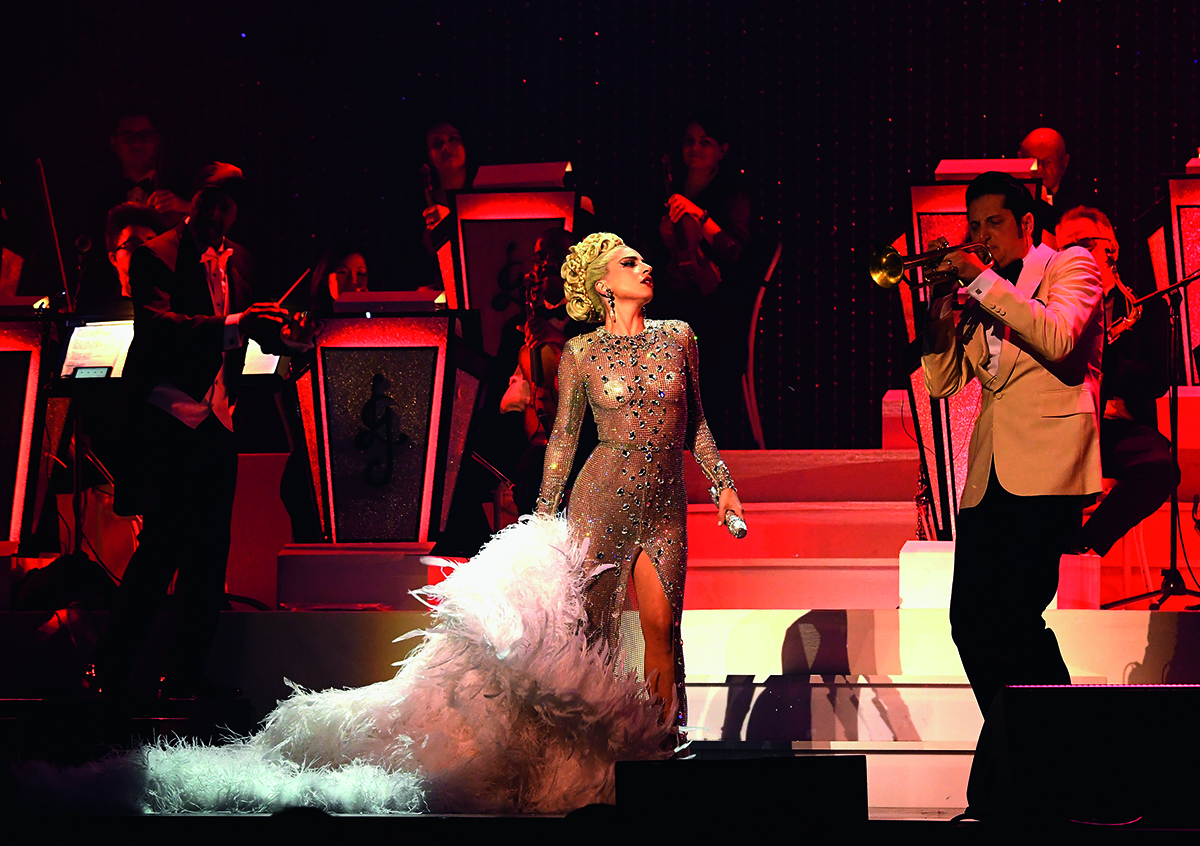
Lady Gaga during her ‘Jazz & Piano’ residency in Las Vegas, 2019. Kevin Mazur/Getty Images for Park MGM Las Vegas.
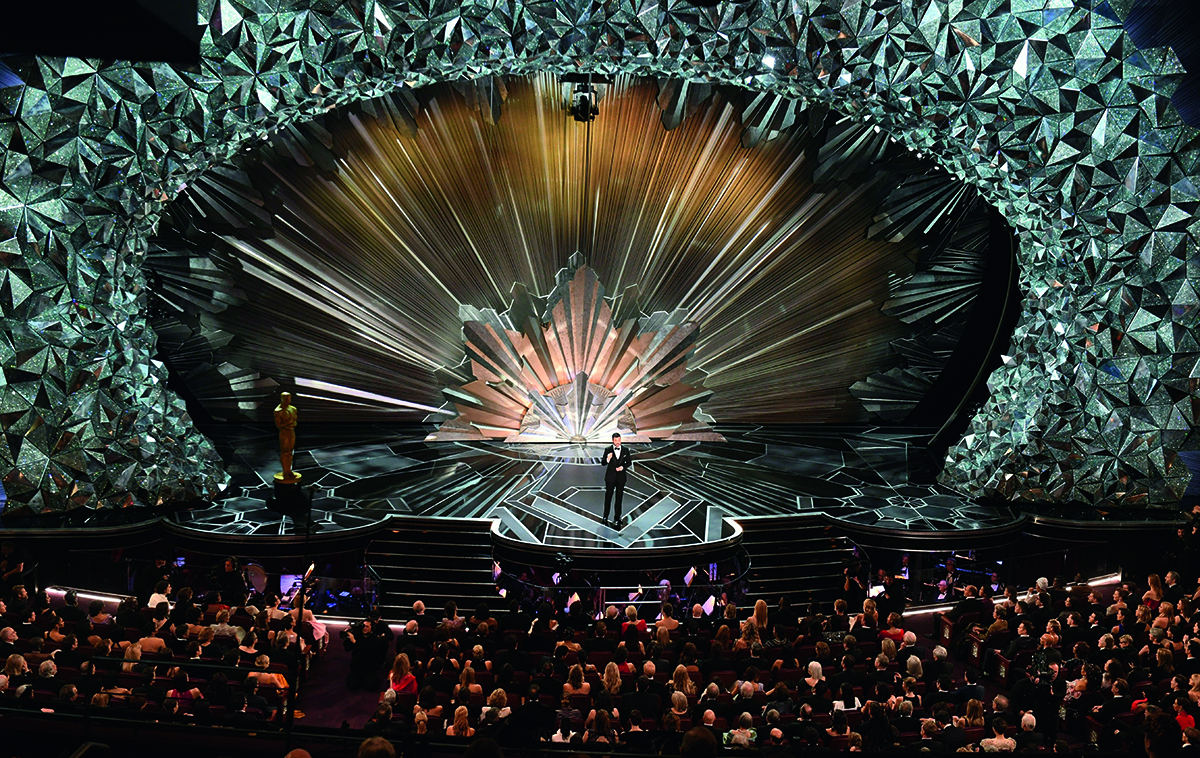
Derek McLane’s design for the Academy Awards stage in 2018, using millions of Swarovski crystals. Mark Ralston/AFP/Getty Images
The relationships are best when they are symbiotic. In 2019, Katrantzou designed her Temple of Poseidon couture collection that was staged as a charitable fundraising event in her native Athens with £40k worth of crystal. “Nadja Swarovski has changed the perception of how crystal is perceived, and I have challenged my own preconceptions of it. With something so visually present, it has to be part of the process from the beginning. We never want it to look like an afterthought,” says Katrantzou.
In turn, creative directors have been invited to Swarovski and been given carte blanche to design jewellery collections and components. The results have given crystal new dimensions. Consider Jean-Paul Gaultier’s Kaputt shiny/matte faceted stones, and the one million giant pearls and stones that embellished Olivier Rousteing’s first couture collection for Balmain in 2019. Challenging perceptions, groundbreaking Dutch couturier Iris van Herpen designed a ‘growing crystal’ that features raw and faceted surfaces.
‘Growing’ Swarovski into a new era is the mission for the family now. An era that is challenging for any consumer-facing business: but any company that has lived through two World Wars and a Great Depression has long-term survival in its genes. Sparkle is guaranteed, but who can say what poignant shapes it might find in the future?
For more information visit: swarovski.com
This article features in the Autumn 2020 Issue, hitting newsstands in October.

Looks from the Brøgger PS19 Collection
Bright colours, androgynous silhouettes and billowing fabrics: just three of the reasons we’re currently obsessed with womenswear label Brøgger. We speak to the Danish co-founders Julie Brøgger and Linn Norström Weiler about Renaissance fashion, dressing with confidence and HRH Queen Margrethe of Denmark

Linn Norström Weile & Julie Brøgger
1. Describe the Brøgger mood
Julie and Linn: Bold, with a play on the feminine versus the masculine.
2. If you could travel back in time to a fashion era from the past when would it be and why?
Julie: Late 1920s/early 30s, I would try and run between Coco Chanel and her rival, Elsa Schiaparelli’s ateliers, just to observe these women change fashion forever. They did it in such different ways, but it is hard to think of anyone else other than these two – they were and still are the epitome of modernism.
Follow LUX on Instagram: the.official.lux.magazine
Linn: I agree with Julie, but I have to highlight the Renaissance as well. Especially in Italy, where art and extravagant fashion was thriving. Maybe I’m drawn to it because it is in such contrast to our Scandinavian simplistic heritage.
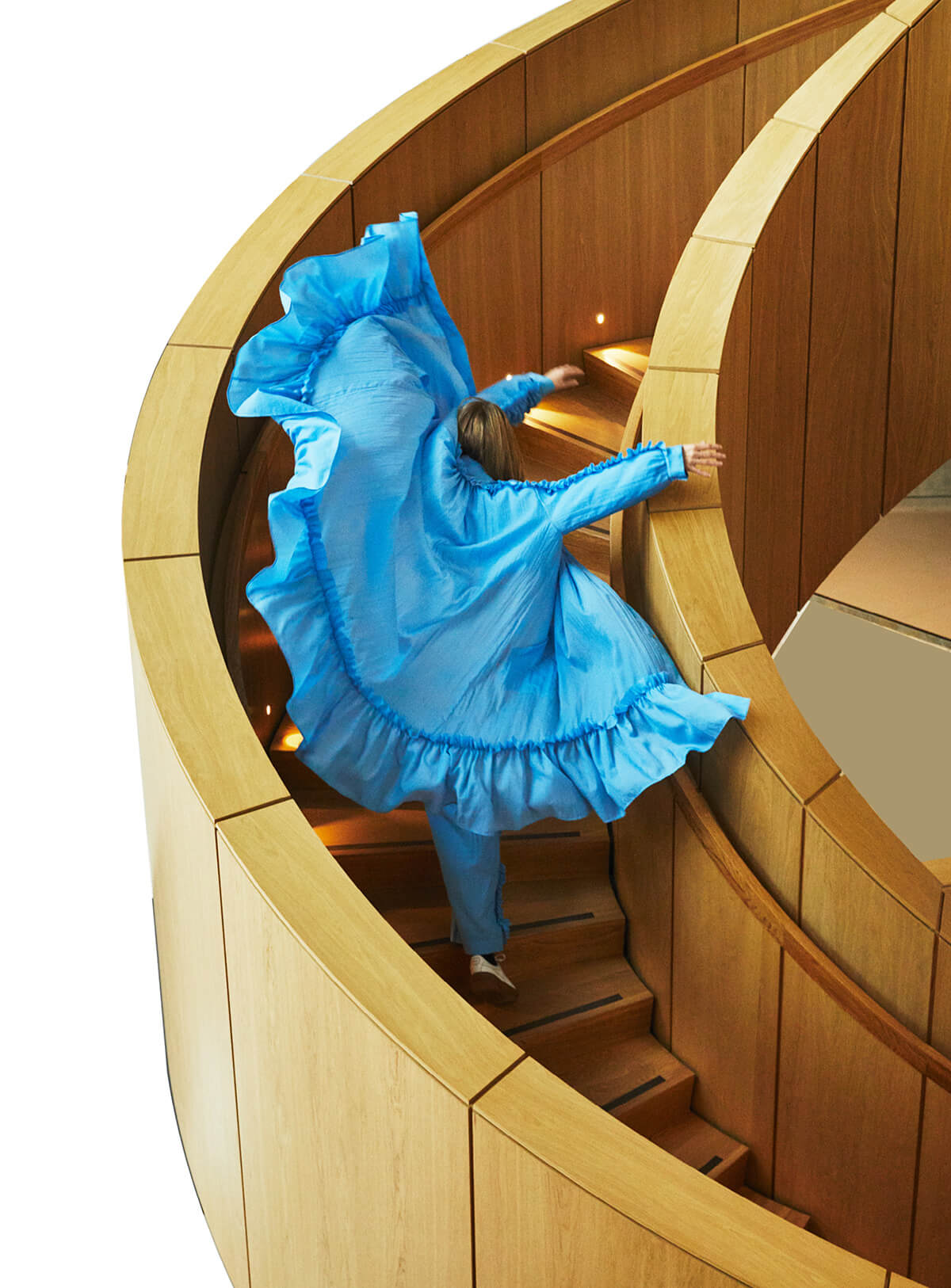
Look from the Brøgger AW18 Collection
3. Is there such thing as a fashion faux pas?
Julie: Not really, as long as you wear it with conviction and confidence anything goes. We all know that feeling when your friend wears something a bit ridiculous but makes it looks so cool and effortless, then you try to replicate and it’s a disaster.
Linn: Hear! Hear! In addition to confidence and conviction it’s about dressing to your body type and height, don’t force it if it doesn’t fit.
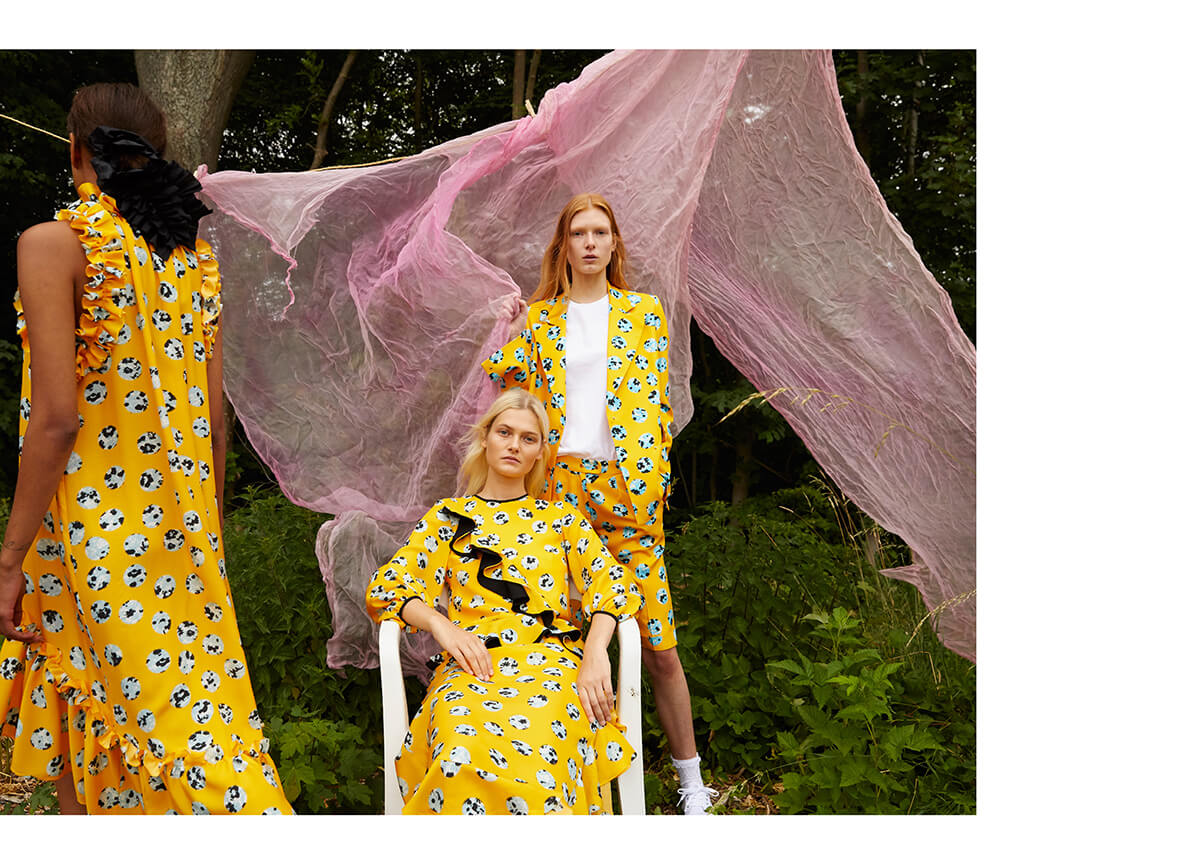
Looks from the Brøgger PS19 Collection
4. What do you never leave the house without?
Julie: Dog poo bags….they seem to turn up in every pocket and bag. Now I find them really handy – great for disposing gum when you can’t find a bin.
Linn: Staying on theme, baby diapers…
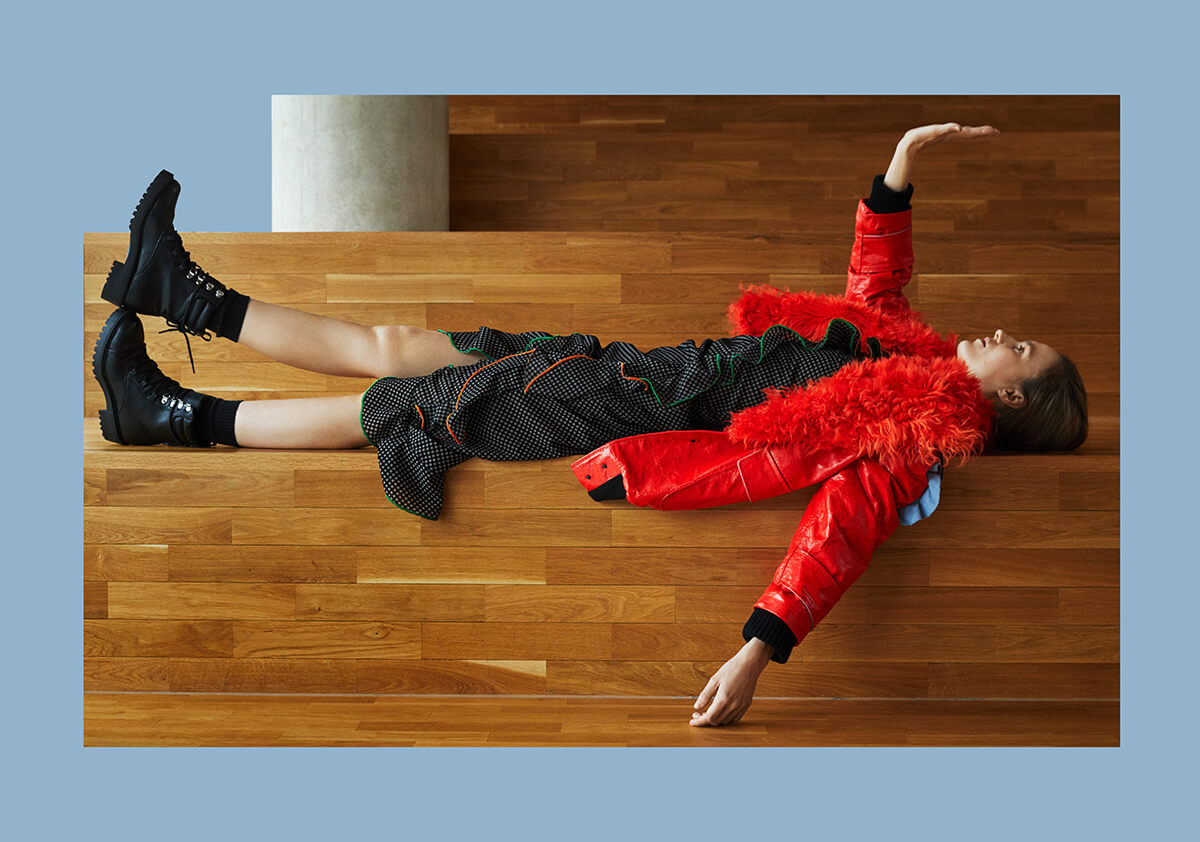
Look from the the Brøgger AW18 Collection
5. What’s inspiring you the most currently?
Linn: This is Julie’s field!
Julie: I’m obsessed with HRH Queen Margrethe of Denmark at the moment, especially the 1980s era where she worked closely with Danish couturiers Erik Mortensen (of Balmain) and Holger Blom (a royal family favourite). She is such a brave and adventurous dresser, I have great respect for that.

Looks from the Brøgger PS19 Collection
6. What’s the best piece of advice you’ve ever been given?
Julie and Linn: Succeeding in the fashion industry requires patience and persistence, there’s no fast lane sadly!
Shop online and view the full collections: brogger.co
Online shopping may be thriving, but the world is awash with swanky boutiques offering indulgent fantasies of every type to the wellheeled and the dreamer synthroid tablets online. KARYS WEBBER picks some of the best
Chanel, Paris
For fashion lovers, no one tops Chanel of course, and while a visit to any of the iconic fashion house’s worldwide boutiques is a treat, for the most hedonistic experience it must be the Avenue Montaigne store in Chanel’s home city, Paris. A stone’s throw away from the legendary Coco Chanel’s old living quarters at Rue Cambon, the 600 square metre store, designed by Chanel’s resident architect and interior designer Peter Marino, is in fact partly inspired by Mademoiselle Chanel’s apartment, echoing the timeless modernity and elegance which epitomises the brand. Tweed wall panels, rock crystal chandeliers by Goossens, pearl embroidered curtains and Ingrid Donat coffee tables come together inside the store which centres around a theatrical double height space devoted to the most precious of accessories and exceptional pieces from the Métiers d’Art collections. Adjoining rooms offer up two spaces dedicated to watches, two to accessories, one showcasing shoes and a VIP salon, whilst the first floor houses the ready-to-wear collection. The classic Chanel colour scheme of pearly whites, glossy blacks, beiges and gold is as evident as ever with contemporary works of art from the likes of Idris Khan, Jean-Michael Othoniel and Mark Swanson thrown in for good measure. chanel.com
Harry Winston, Paris
Arguably the most hedonistic item to purchase, diamonds are of course a girl’s best friend and nowhere more so than at Harry Winston’s Shanghai Pavilion. The 80-year-old luxury brand, renowned for being the jeweller to the stars, opened the unique store in the prestigious XinTianDi district in 2012, designed with the aim of creating “an experience that was both intimate and monumental”, according to New York-based architect William Sofield. The freestanding boutique aptly shimmers like a jewel from the outside with much of the façade clad in zigzagging panels of clear and misted gold glass, and features a carved stone gateway (a reinterpretation of Shanghai’s historic Shikumen style). Inside, shoppers are greeted by a soaring two-storey oval atrium with a black and white marble floor that references the brand’s Fifth Avenue store. Chinese architecture and its shape-shifting approach to space is cited as part of the design inspiration and as a result few of the shop’s walls are set at right angles and no room is perfectly square, meaning the store appears to evolve before your eyes. Dedicated areas for the brand’s signature collections (such as Sunflower and Cluster) and the High Jewellery collections are each designed with individual materials and colour palettes to compliment the pieces. The store also features a custom-designed Bridal Bar and, for the first time, a designated Timepiece Salon complete with LED screens which display behind-the-scenes footage of the watch development. harrywinston.com
Gastón y Daniela, Madrid
Founded in Bilbao in 1876 and still owned by the same family, Gastón y Daniela is a treasure trove of textiles housed in a grand former mansion in Madrid. The store offers over 40,000 fabrics ranging from contemporary designs (like the new Uptown collection inspired by the use of geometric patterns between the 1930s and 1960s) to unique heritage fabrics from their extensive archives. You can peruse luscious silks, intricate brocades and rich damasks at your leisure whilst enjoying a cup of coffee or a glass of sherry (depending on the hour), which the staff will whip up for you. Alongside the swathes of tactile fabrics, the store also impeccably displays their own wallpaper designs, upholstered furniture and Persian carpets, making it a haven for interior design lovers. Plus, with plush sofas sat in front of fireplaces and a beautiful private garden accessible via the sitting room, you’d be hard pushed to find a more pleasurable retail experience. gastonydaniela.com
Fortnum & Mason, London
One of London’s most iconic and oldest emporiums (and not to mention grocer to the Queen), Fortnum & Mason has been a foodie favourite since it was established over 300 years ago, when it was famous for offering up exotic delicacies from around the world. The quintessentially English store (it stocks over 200 varieties of tea if you were in any doubt about its British heritage) sells everything from cheeses and preserves to macaroons and fudge in its vast food hall, which spans two floors connected by a grand spiral staircase. Gourmet gift hampers are Fortnum & Mason’s forte with signature hampers including the ‘Mayfair’ and ‘West Country’ although bespoke versions can also be stashed with an array of sweet or savoury treats like champagne truffles and beluga caviar. The store also houses five restaurants across its seven floors including the 1707 Wine Bar (named after the store’s foundation year), designed by David Collins, where you can order any bottle of wine from the extensive collection in the adjacent wine department for just a £10 corkage fee. Alternatively, head to The Parlour on the first floor for a naughty Knickerbocker Glory. fortnumandmason.com
Alfred Dunhill, London
Alfred Dunhill’s flagship store (or ‘home’ as the brand likes to call it) is a former Georgian mansion in the heart of swanky Mayfair, which was previously the residence of the Duke of Westminster. The British luxury label has been dressing the most discerning gentlemen with their exquisitely crafted goods for over 100 years and everything from leather brogues to silk pocket squares are available over three spacious floors, alongside a bespoke tailoring room for custom-made garments. Not just an impeccable shopping experience however, the grade II listed building also doubles up as an exclusive members club with other on-site offerings including a marble-clad spa and an intimate, traditional barbers where men can treat themselves to a classic wet shave. The Cellar Bar meanwhile serves up a perfectly spicy Bloody Mary as well as providing the food for the charming courtyard restaurant. Plus, for film buffs bored of the generic multiplex experience, there’s a luxurious subterranean private cinema room, equipped with the finest visual and audio equipment from Meridian, which is available for hire. dunhill.co.uk
Bijan, Beverly Hills
Unashamedly billed as “the world’s most expensive store”, Bijan is an exclusive appointment-only boutique housed in an extravagant Mediterraneanstyle palazzo on Beverly Hills’ famous Rodeo Drive. Founded by Iranian designer Bijan Pakzad in 1976 (though now run by his business partner Dar Mahboubi since Pakzad’s passing in 2011), Bijan is predominantly a menswear store offering ‘one of one creations’ of the utmost opulence and finest quality (a coat made out of vicuña wool for example, the rarest and most expensive material in the world, for an eye-watering USD 15,000). The store counts the most powerful men of politics and fashion as clients, including Presidents Ronald Reagan, Barack Obama and Vladimir Putin and designers Oscar de la Renta and Tom Ford. Alongside fashion, Bijan is also known for its perfume range (currently consisting of 14 unique scents for both men and women, all contained in elegant Baccarat crystal flaçons) and custom-designed accessories with past requests including bulletproof lined jackets, chinchilla bedspreads and, naturally, bespoke yacht and private jet accessories. The last and most lavish string to Bijan’s bow however is luxury supercars, born out of Pakzad’s personal passion for them, which has culminated in a series of limited edition and highly bespoke Rolls-Royce and Bugatti Veyron cars being designed exclusively for the store. bijan.com
Lane Crawford, Greater China
Originally a provisions trading post for the navy in 1850, Lane Crawford is today a benchmark for innovation due to its retail concepts and design. Spearheading retail indulgence across the region since the 70s, the retail mogul brings the world’s most luxurious and coolest brands to Hong Kong, Beijing, Shanghai, and soon to Chengdu. With more than 602,000 square feet of prime real estate across five stores in three of the world’s most expensive cities, Lane Crawford doesn’t have branded shopin- shops like many other department stores but instead whisks its Louboutin-clad customers across its meticulously curated displays – much like reading a magazine from cover to cover. Clean-cut, contemporary and sleek, the stores house menswear, women’s wear, beauty, homewear and even a dedicated music bar where patrons can order complimentary coffee while sampling the world’s newest tunes on iPods. Oh, and the next time you’re looking for that perfect gown or clutch, you might want to check in and ask for the collection that won’t be shown on the racks. lanecrawford.com
Roja Dove, Harrods, London
Offering a welcome respite from the never-ending stream of mass-market fragrances, esteemed master perfumer Roja Dove (regarded as the ‘connoisseur’s connoisseur’) creates scents that are full of emotion, sophistication and ‘grounded in memories of love’. At the Roja Dove Haute Parfumerie, nestled in a hard-tofind enclave of iconic department store Harrods, scent is regarded as powerfully evocative and incredibly personal. Customers seeking true fragrance fulfillment can embark upon a unique journey to ‘unlock their perfume personality’ in the intimate space which is lavishly decorated with mirrors and black lacquer furniture. If you don’t fancy the completely bespoke service however, elaborate crystal decanters containing pre-made Roja Dove fragrances are still created using the finest and rarest raw materials in the world including Jasmine de Grasse and Rose de Mai (both from the South of France and more expensive than a gold bullion). The store also offers Mr Dove’s own personal edit of the most luxurious fragrances from other renowned perfume houses including Guerlain and Clive Christian (the latter famous for producing the world’s most expensive perfume, the Clive Christian No. 1, the bottle of which was decorated with diamonds and cost a whopping £115,000). rojadove.com
Level Shoe District, Dubai Mall, Dubai
 Dubai doesn’t often do things by halves so it’s no surprise that the cosmopolitan city boasts the world’s largest shoe store, within the world’s largest shopping centre. The Level Shoe District is 96,000 square feet dedicated purely to luxury footwear and is home to over 250 brands, of which, over 100 are exclusive to the region and 40 are stand-alone designer boutiques. To avoid overwhelming shoppers with such a vast shoe metropolis, the store is divided into four more digestible sections: Women’s Designer, Women’s Contemporary, Men’s and Trends, with each quarter designed with its own distinct aesthetic and ambience. Among Women’s Designer – a chic boudoir-esque space with gilt birdcages and a powder pink colour scheme – you’d be hard pushed to find an international designer brand missing with everything from Valentino and Louis Vuitton to Miu Miu and Alexander Wang elegantly displayed. Women’s Contemporary meanwhile features the more cutting edge, up-and-coming luxury designers like British exports Nicholas Kirkwood and Sophia Webster. Men have everything from Berluti to Oliver Sweeney at their fingertips as well as concept store The Cobbler, which is designed like a gentleman’s club and offers traditional shoe repair and a bespoke service workshop. On top of this, visitors who are exhausted after a hard day’s retail therapy can indulge in a treatment at the Sole Lounge by Margaret Dabbs (the renowned celebrity podiatrist’s only foot spa outside the UK) or treat themselves to high tea at the region’s first Vogue Café, which is decorated with iconic photography from the fashion magazine’s archives. levelshoedistrict.com
Dubai doesn’t often do things by halves so it’s no surprise that the cosmopolitan city boasts the world’s largest shoe store, within the world’s largest shopping centre. The Level Shoe District is 96,000 square feet dedicated purely to luxury footwear and is home to over 250 brands, of which, over 100 are exclusive to the region and 40 are stand-alone designer boutiques. To avoid overwhelming shoppers with such a vast shoe metropolis, the store is divided into four more digestible sections: Women’s Designer, Women’s Contemporary, Men’s and Trends, with each quarter designed with its own distinct aesthetic and ambience. Among Women’s Designer – a chic boudoir-esque space with gilt birdcages and a powder pink colour scheme – you’d be hard pushed to find an international designer brand missing with everything from Valentino and Louis Vuitton to Miu Miu and Alexander Wang elegantly displayed. Women’s Contemporary meanwhile features the more cutting edge, up-and-coming luxury designers like British exports Nicholas Kirkwood and Sophia Webster. Men have everything from Berluti to Oliver Sweeney at their fingertips as well as concept store The Cobbler, which is designed like a gentleman’s club and offers traditional shoe repair and a bespoke service workshop. On top of this, visitors who are exhausted after a hard day’s retail therapy can indulge in a treatment at the Sole Lounge by Margaret Dabbs (the renowned celebrity podiatrist’s only foot spa outside the UK) or treat themselves to high tea at the region’s first Vogue Café, which is decorated with iconic photography from the fashion magazine’s archives. levelshoedistrict.com
Hajenius, Amsterdam
Housed in a historic Art Deco building on Amsterdam’s Rokin boulevard since 1915 (though the company dates back to as early as 1826), the renowned House of Hajenius is widely regarded as one of Europe’s leading cigar houses. With the interior remaining virtually unchanged since Hajenius’ inception, cigar aficionados are greeted with a remarkable backdrop of fine Italian marble, oak panelling and colossal chandeliers that date back to a time when Amsterdam was still lit by gas, before so much as a whiff of a tobacco. Venture further in and the finest selection of cigars are available, from Hajenius’ own brand to an entire room dedicated to Havanas as well as cigars from Sumatra and Brazil, plus smoking accessories ranging from lighters and cigarette holders to handmade clay and ceramic pipes. In addition to the retail aspect, the grand building also houses an exceptional walk in humidor that features a richly decorated vaulted ceiling – the doors are activated by a key fob held by staff members who screen entrants – and regular cigar and whisky tasting evenings are held at the venue. hajenius.com
Recent Posts
Archives
- December 2025
- November 2025
- October 2025
- September 2025
- August 2025
- July 2025
- June 2025
- May 2025
- April 2025
- March 2025
- February 2025
- January 2025
- December 2024
- November 2024
- October 2024
- September 2024
- August 2024
- July 2024
- June 2024
- May 2024
- April 2024
- March 2024
- February 2024
- January 2024
- December 2023
- November 2023
- October 2023
- September 2023
- August 2023
- July 2023
- June 2023
- May 2023
- April 2023
- March 2023
- February 2023
- January 2023
- December 2022
- November 2022
- October 2022
- September 2022
- August 2022
- July 2022
- June 2022
- May 2022
- April 2022
- March 2022
- February 2022
- January 2022
- December 2021
- November 2021
- October 2021
- September 2021
- August 2021
- July 2021
- June 2021
- May 2021
- April 2021
- March 2021
- February 2021
- January 2021
- December 2020
- November 2020
- October 2020
- September 2020
- August 2020
- July 2020
- June 2020
- May 2020
- April 2020
- March 2020
- February 2020
- January 2020
- December 2019
- November 2019
- October 2019
- September 2019
- August 2019
- July 2019
- June 2019
- May 2019
- April 2019
- March 2019
- February 2019
- January 2019
- December 2018
- November 2018
- October 2018
- September 2018
- August 2018
- July 2018
- June 2018
- May 2018
- April 2018
- March 2018
- February 2018
- January 2018
- December 2017
- November 2017
- October 2017
- September 2017
- August 2017
- July 2017
- June 2017
- May 2017
- April 2017
- March 2017
- February 2017
- January 2017
- December 2016
- November 2016
- October 2016
- September 2016
- August 2016
- July 2016
- June 2016
- May 2016
- April 2016
- March 2016
- February 2016
- November 2015
- September 2015
- June 2015
- May 2015
- March 2015
- September 2014
- August 2014
- July 2014
- May 2014
- April 2014
- March 2014
- February 2014
- January 2014
- December 2013
- November 2013
- October 2013
- September 2013
- August 2013
- July 2013
- June 2013
- April 2013
- March 2013
- February 2013
- September 2012
- July 2012
- June 2012
- March 2012
- February 2012
Categories
- Adventure Travel Issue
- Aesthete Issue
- Architecture
- Art & Design
- Art & Photography
- Art collectors
- Autumn 19
- Autumn/Winter 2020/2021
- Autumn/Winter Issue
- Bespoke Issue
- Business
- Cars
- Cars & Collectibles
- Case Study
- Celebrities
- Culture
- Culture Issue
- Design Issue
- Dining Issue
- Earth Issue
- Family Issue
- Fashion & Jewellery
- Features
- Food
- Future Luxury Issue
- Health
- Hedonism Issue
- Image Issue
- Italy Issue
- Latest Stories
- Leaders & Philanthropists
- Leaders Slider
- Love Issue
- Luxury Travel Issue
- New Luxury Issue
- Online Exclusive Slider
- Opinion
- Spring 2020
- Summer 19 Issue
- Summer 2020
- Summer 2021
- Sustainability
- Taste Issue
- The Beauty Issue
- Travel
- Uncategorized
- Water Issue
- Winter 19 Issue
Popular Posts
Categories
- Adventure Travel Issue
- Aesthete Issue
- Architecture
- Art & Design
- Art & Photography
- Art collectors
- Autumn 19
- Autumn/Winter 2020/2021
- Autumn/Winter Issue
- Bespoke Issue
- Business
- Cars
- Cars & Collectibles
- Case Study
- Celebrities
- Culture
- Culture Issue
- Design Issue
- Dining Issue
- Earth Issue
- Family Issue
- Fashion & Jewellery
- Features
- Food
- Future Luxury Issue
- Health
- Hedonism Issue
- Image Issue
- Italy Issue
- Latest Stories
- Leaders & Philanthropists
- Leaders Slider
- Love Issue
- Luxury Travel Issue
- New Luxury Issue
- Online Exclusive Slider
- Opinion
- Spring 2020
- Summer 19 Issue
- Summer 2020
- Summer 2021
- Sustainability
- Taste Issue
- The Beauty Issue
- Travel
- Uncategorized
- Water Issue
- Winter 19 Issue
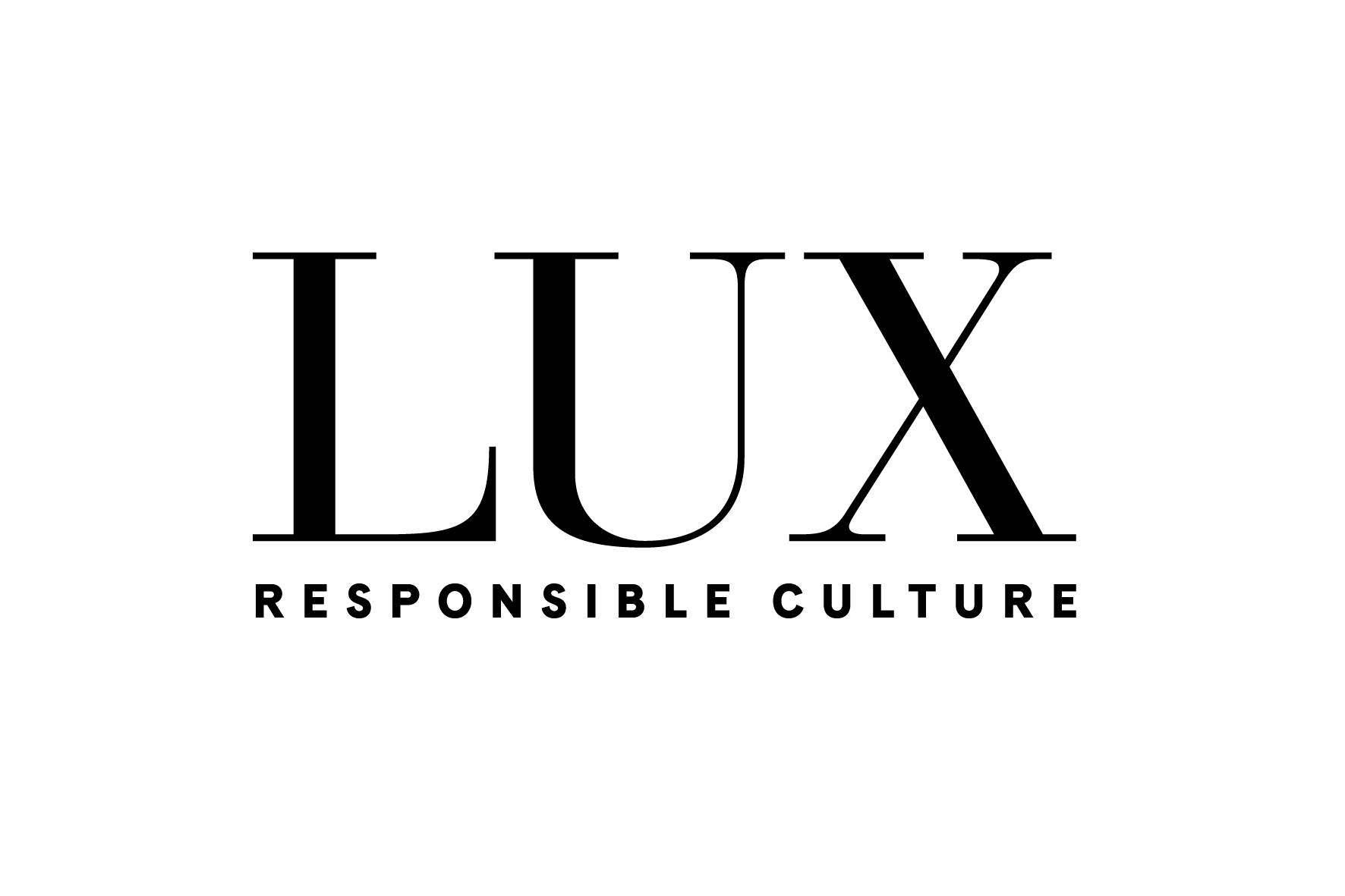

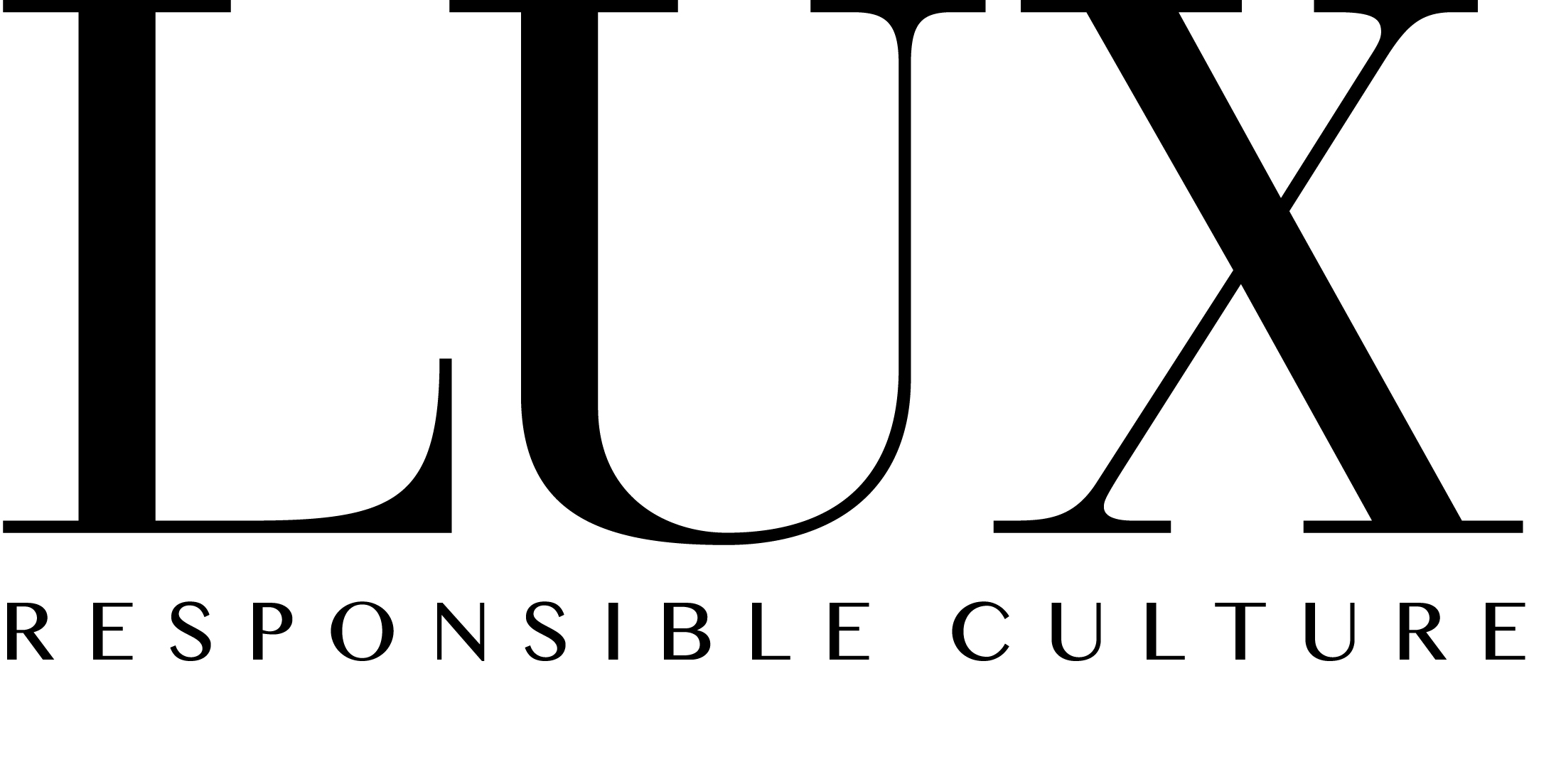

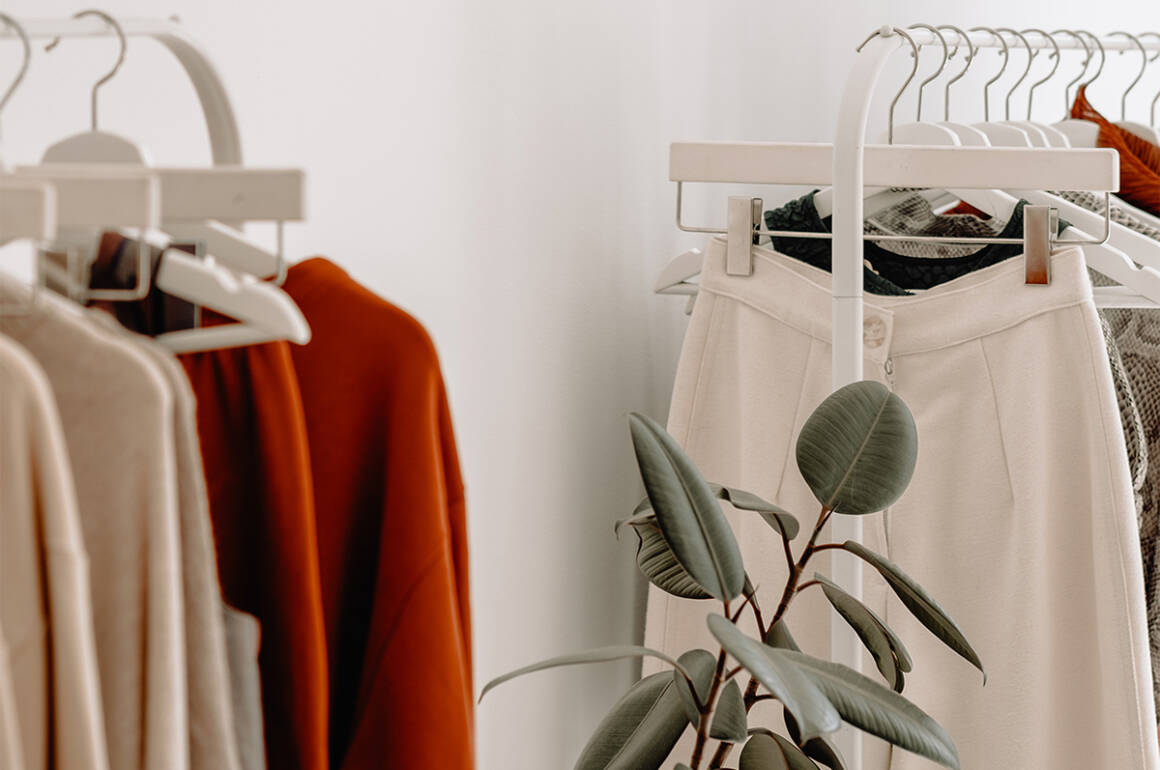
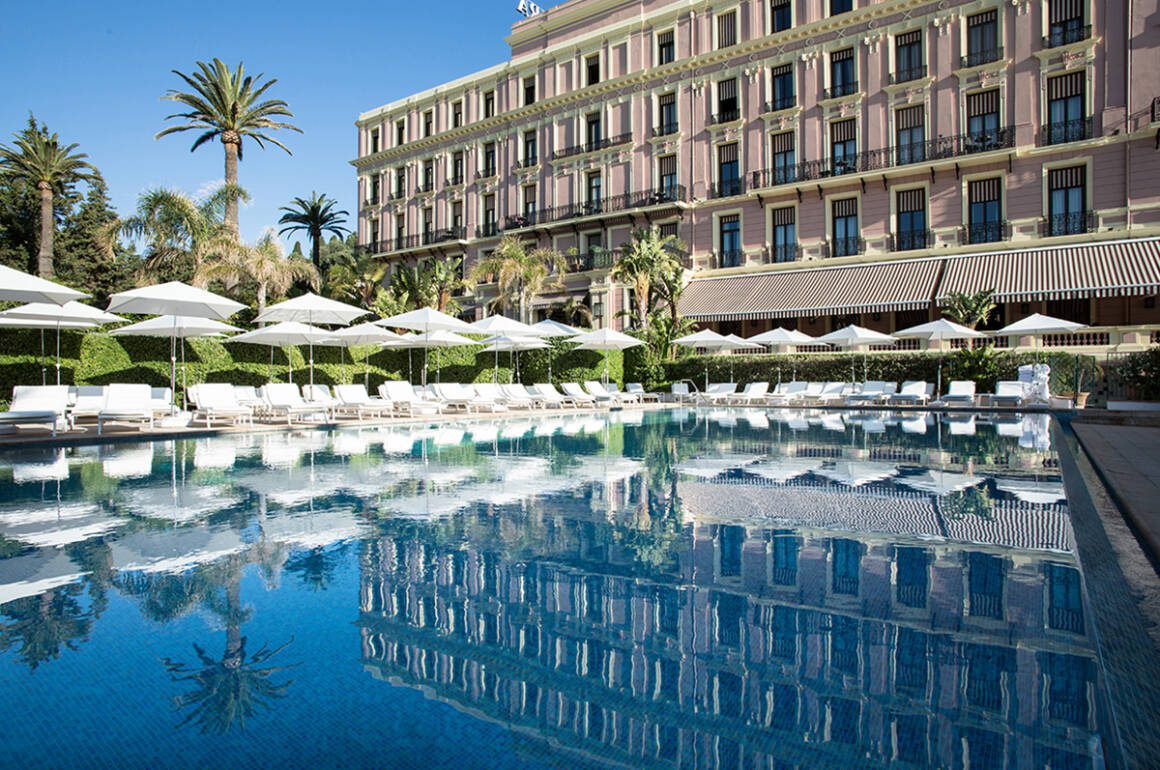

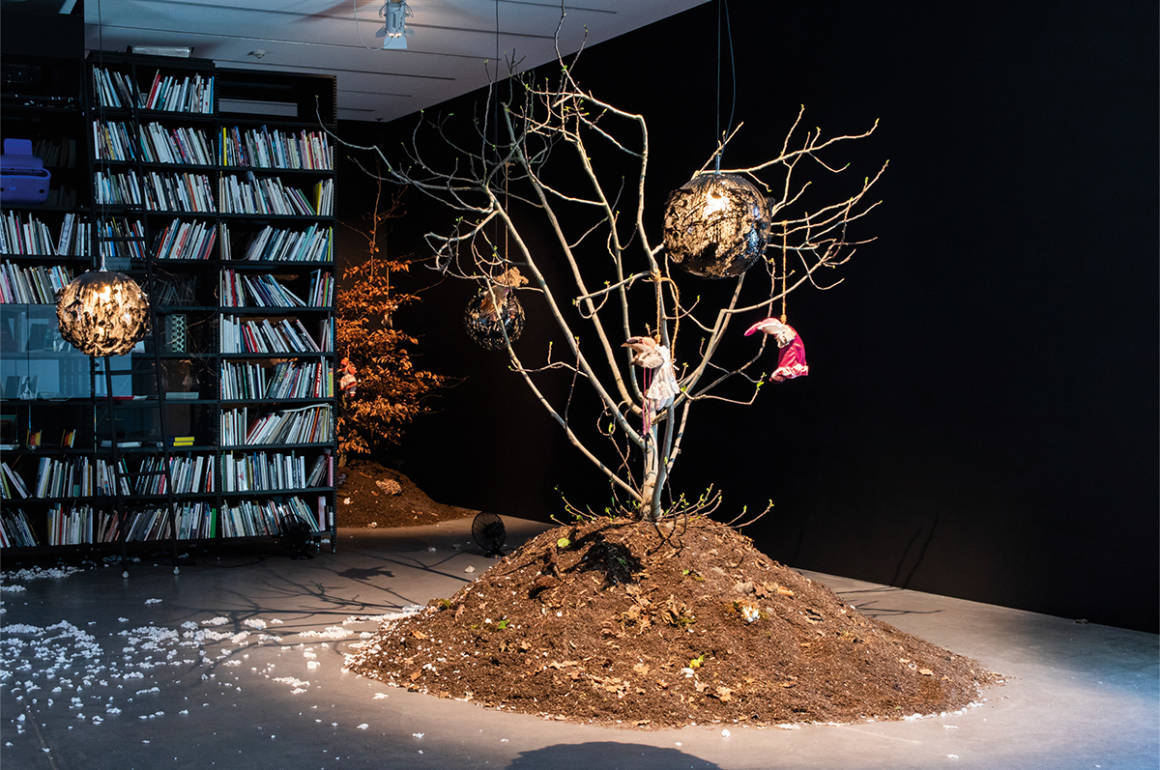
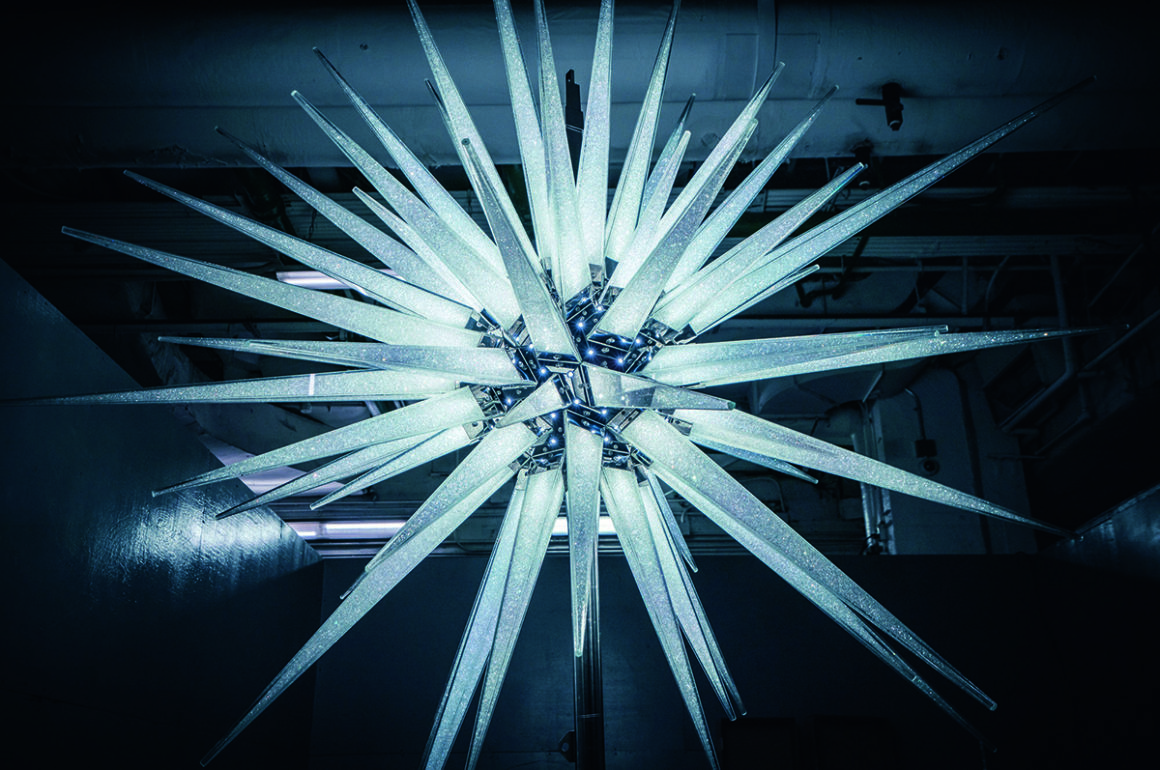
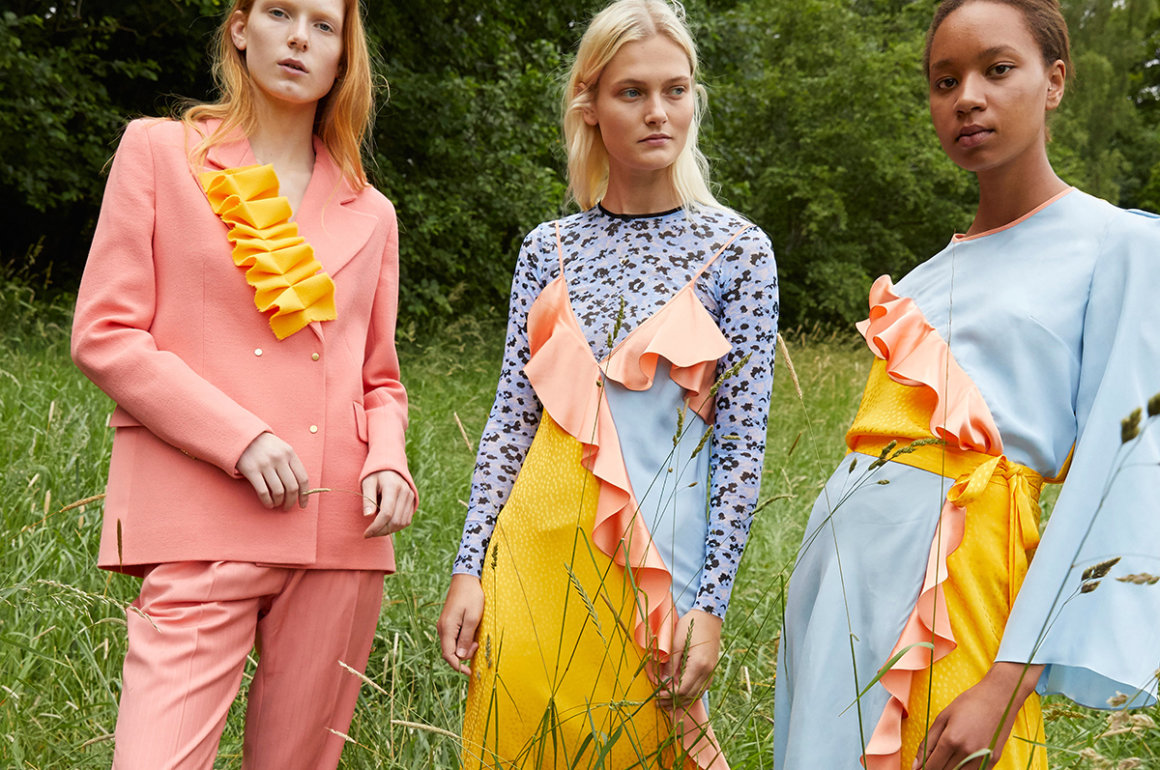













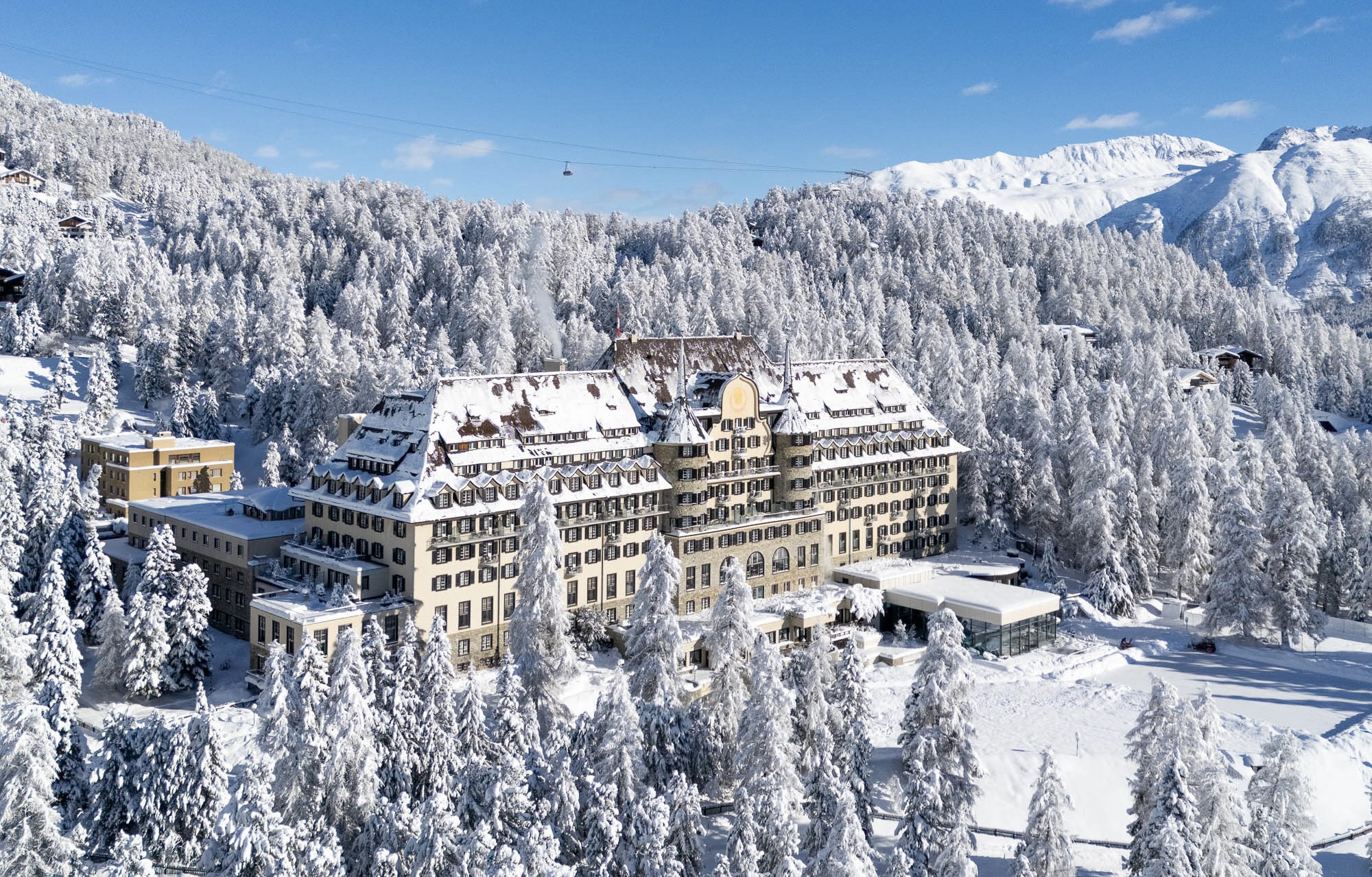
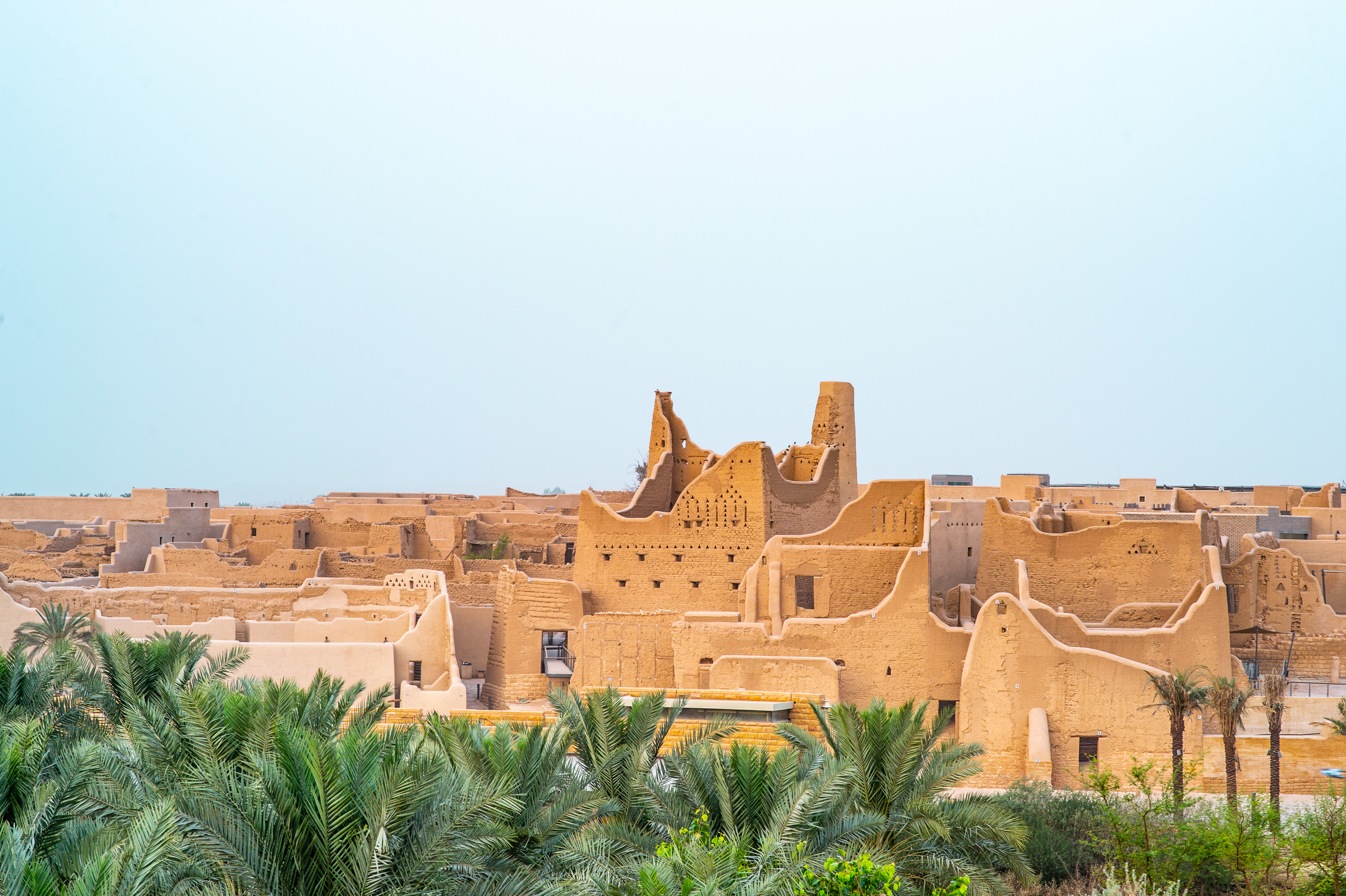
Recent Comments